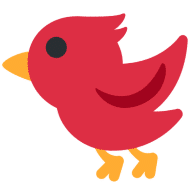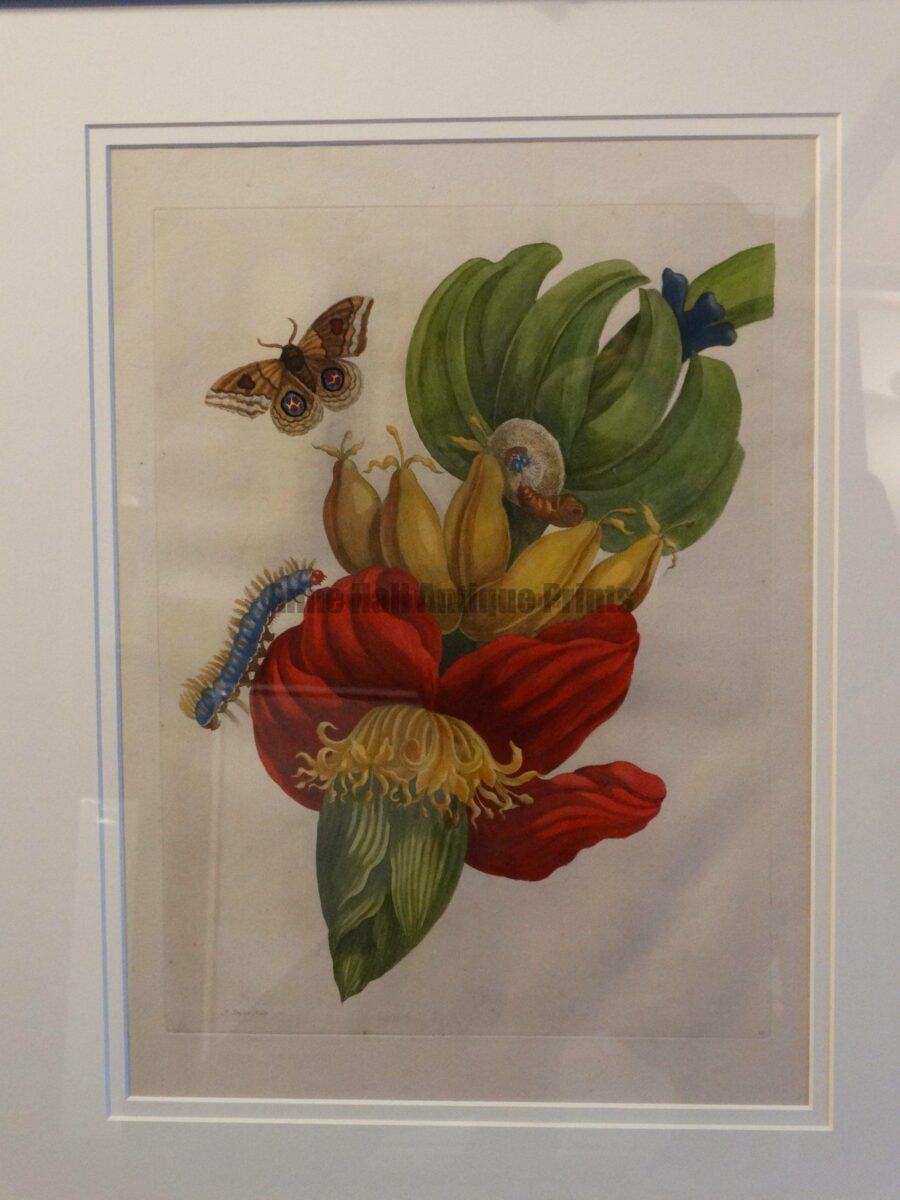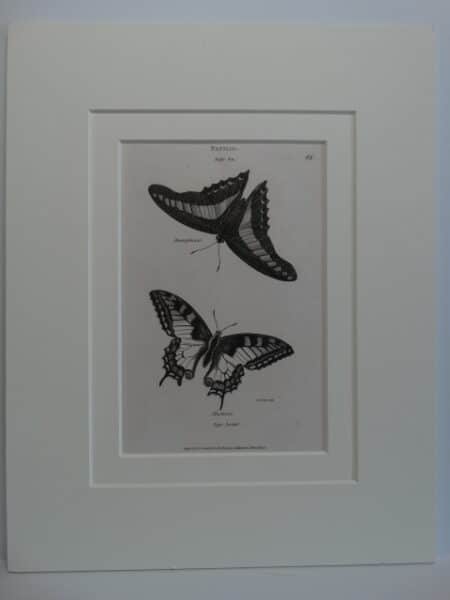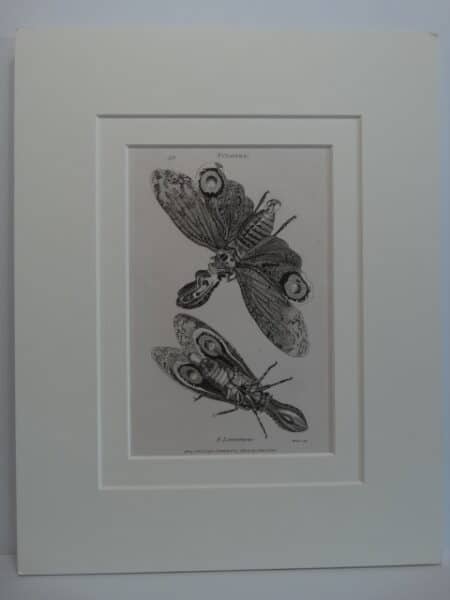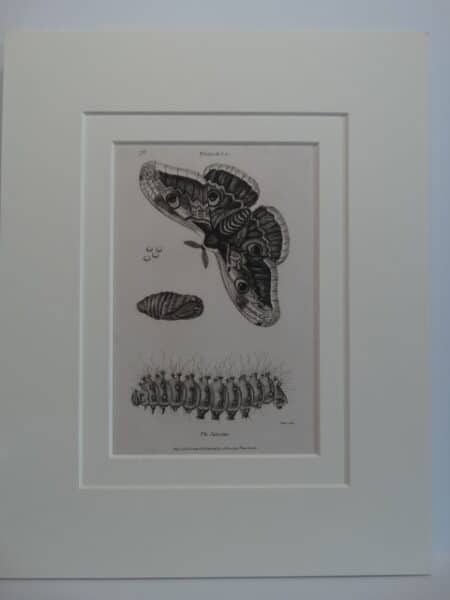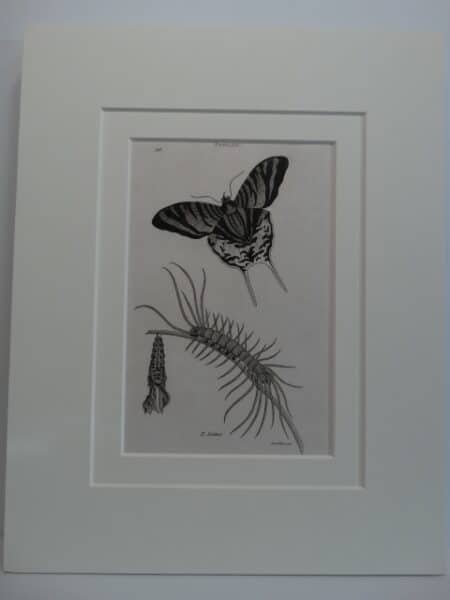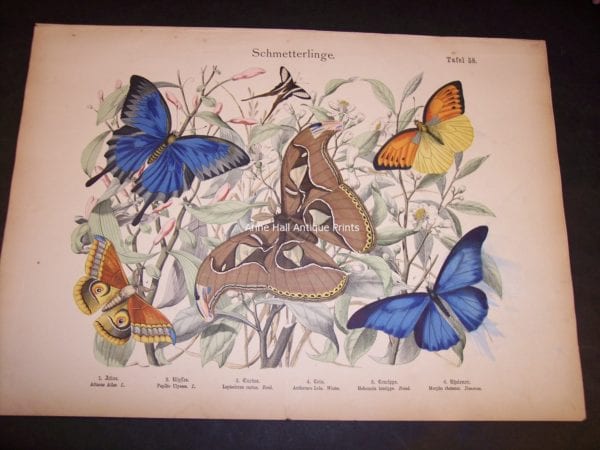Available 18th century engravings by Maria Sybilla Merian: Metamorphosis Insectorum Surinamensium and Insects of Europe. The Aurelian by Moses Harris, as well as additional works by other authors & entomology artists.
Our insect prints are antiques, that means they are over 100 years old. Our engravings and lithographs, documented the transformations of butterflies & bugs centuries ago. Here you can learn about & buy original bookplates.
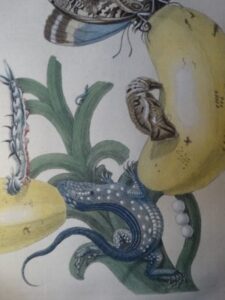
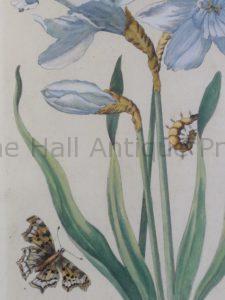
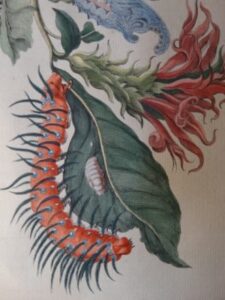
Insect Prints by Maria Sybilla Merian Metamorphosibus Insectorum Surinamensium
Original 18th Century Engravings: Insects of Surinam Maria Sybilla Merian
A famous & rare work authored by Maria Sybilla Merian. Her depictions show the multiple stages in insect transformations, witnessed on her travels to Surinam c.1700. The insect prints, precisely detail and documented, butterfly metamorphoses. Merian published her book. It was titled Metamorphosibus Insectorum Surinamensium.
Interesting to note, Merian’s daughters worked on her 1730 “Insects of Surinam.” These prints are hand colored copper plate engravings on hand made hand laid linen rag. Each of the Surinam insect prints measures 14 x 20 1/2.”
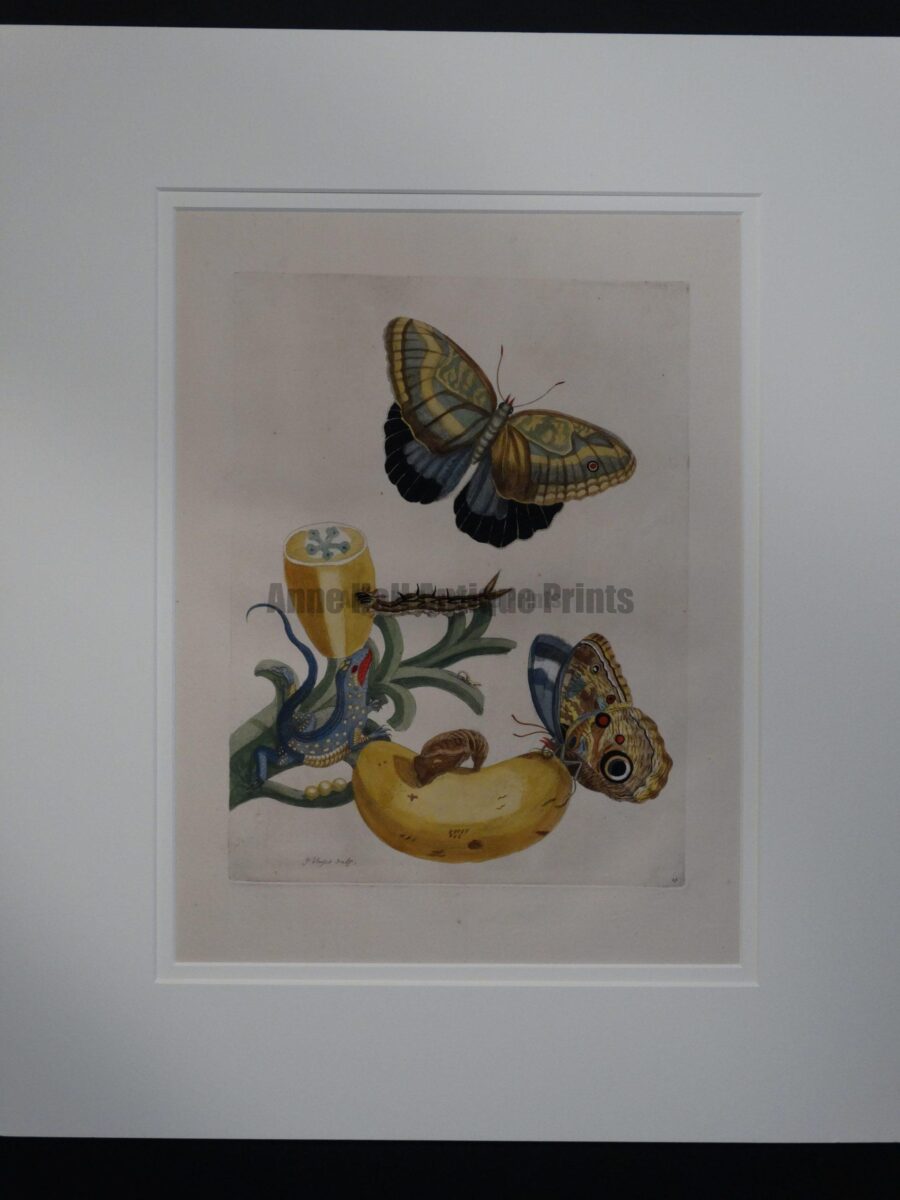
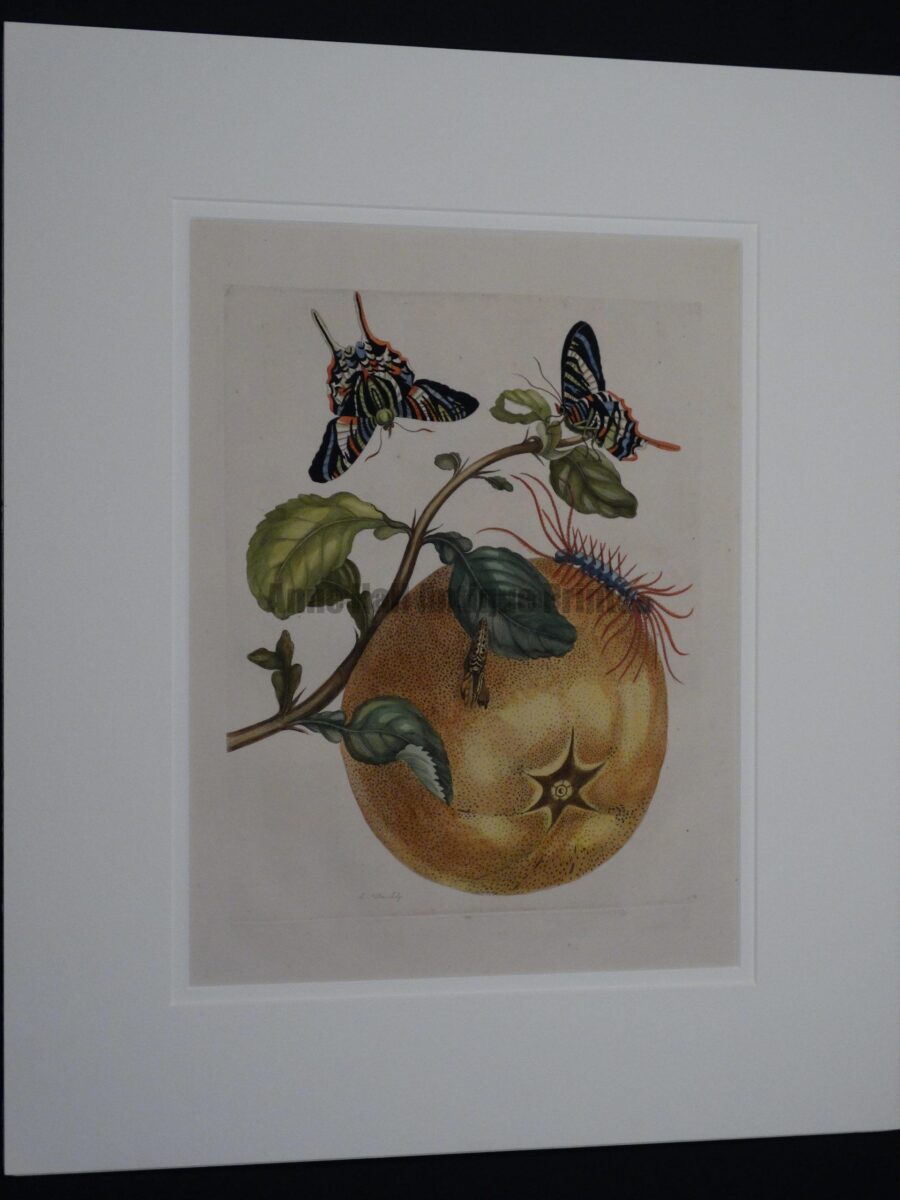
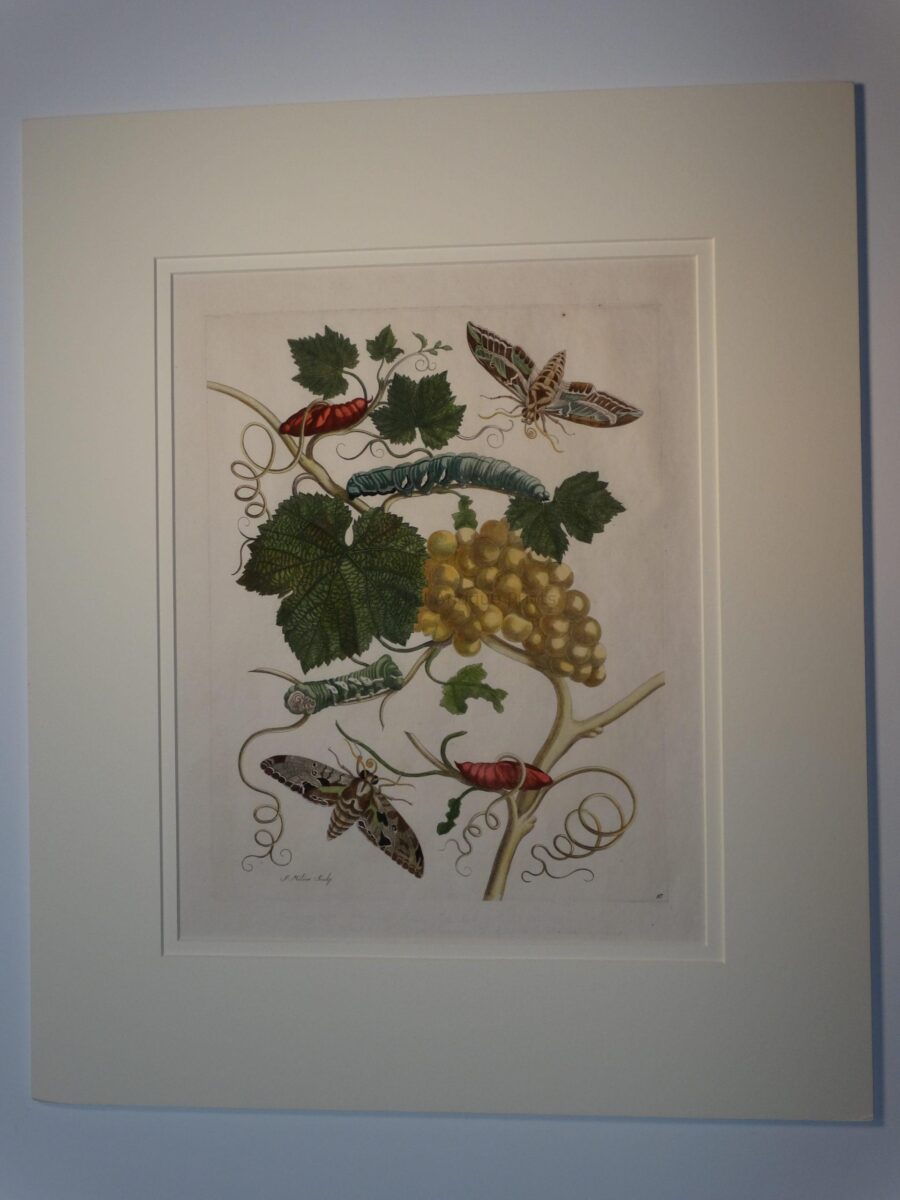
Merian antique insect prints, transformations & butterfly metamorphosis.
These unusual antique prints come from Maria Sibylla Merian’s work entitled Metamorphosibus Insectorum Surinamensium. Published in The Hague, The Netherlands in 1730. The work features the insects and plants of Surinam in the Dutch Colony of South America. Fantastic composition and stunning details make this rare work one of the most sought after botanical or insect works in existence.
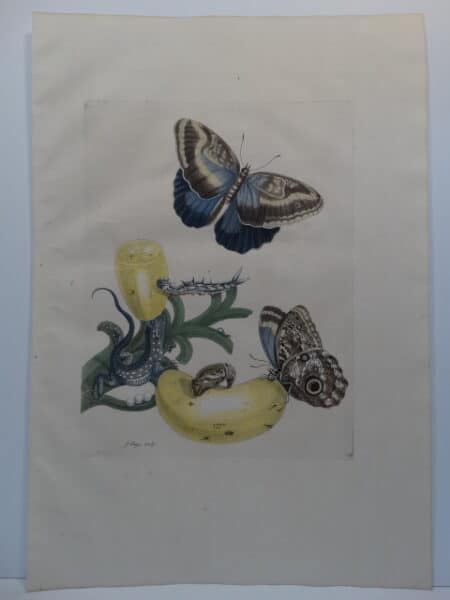
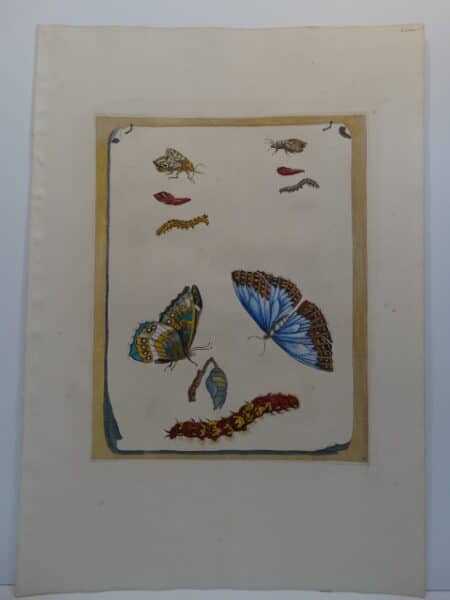
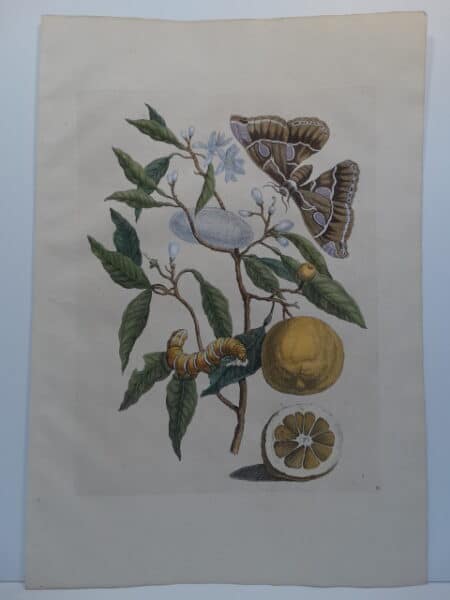
After viewing a collection of insects from South America inspired Merian and her daughter Dorothea Maria to embark on an expedition to Surinam, on the North East corner of South America. She proposed the concept of transformation in Medieval times, to a male run society. She was going to provide proof to the contrary by documenting the transformation, first in water color and then engraved.
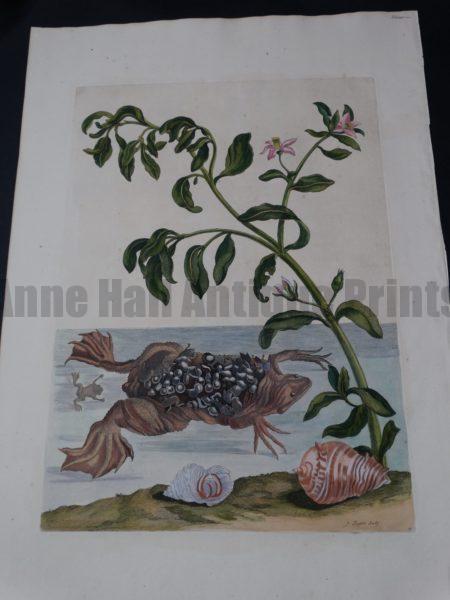
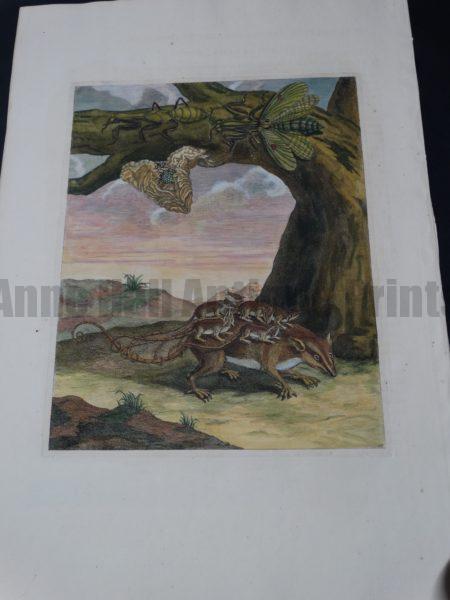
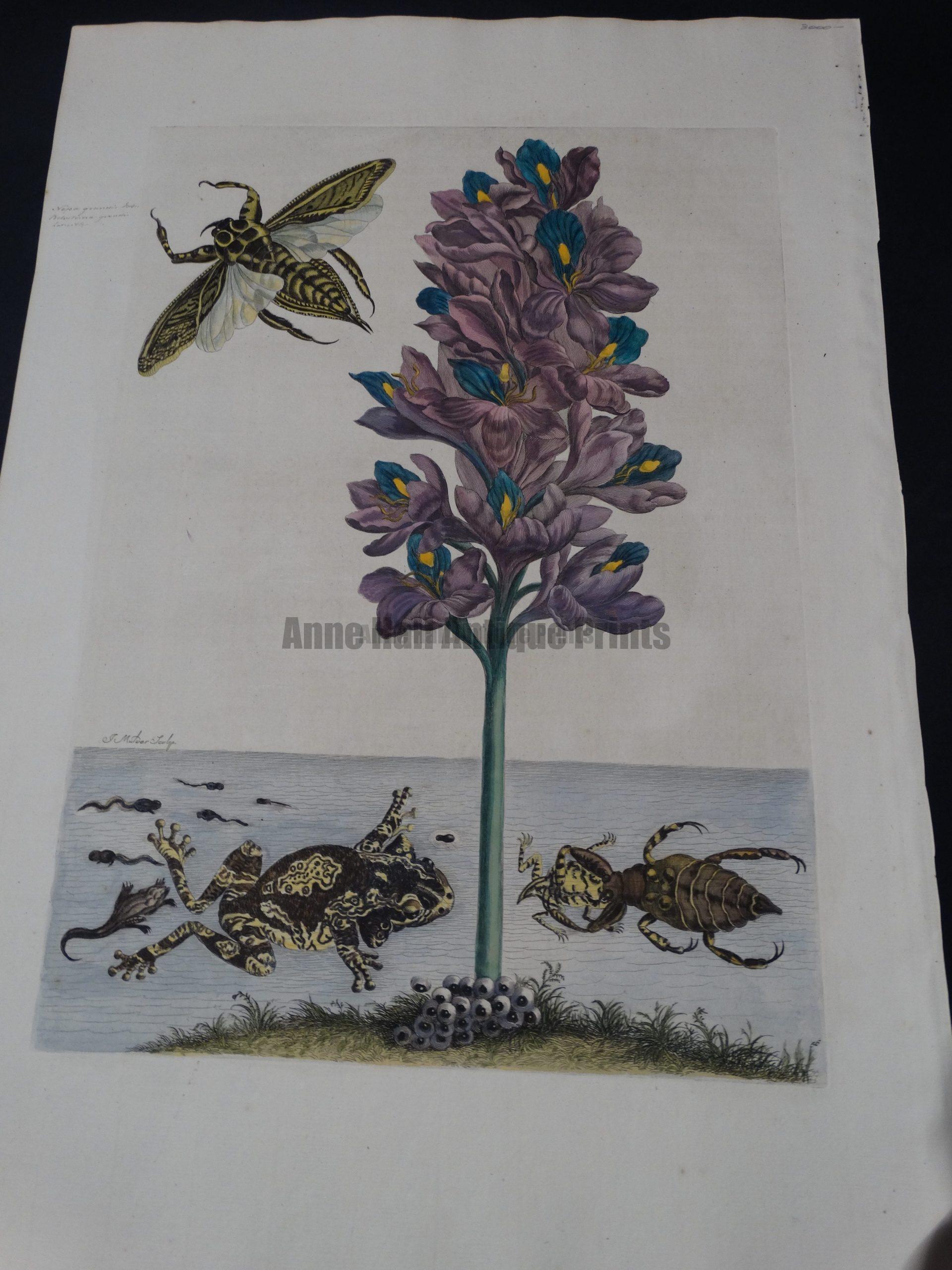
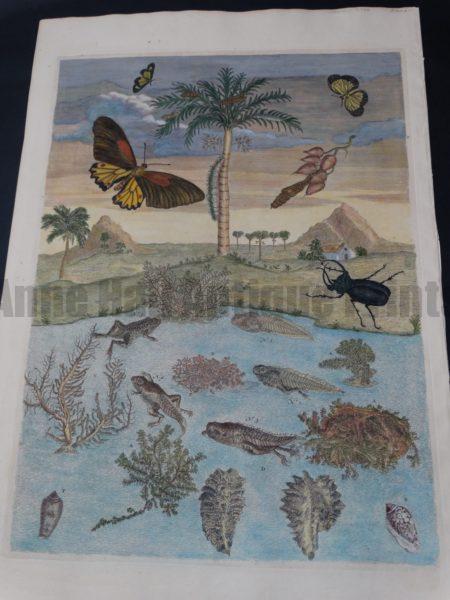
Merian’s large folio, was the result of going to such a remote area. A remarkable adventure for a young woman. It took her months to get to there and months to get back to Europe. And later lead to her death. Thankfully her daughters helped to complete this magnificent work on transformations. Her work focused on Surinamese flora and the entomology there. Her Insects of Surinam and Insects of Europe illustrate the Transformations & Metamorphosis of Insects and the plants on which they fed. Considered as some of the most famous documents published on the subject of Insect transformation during the 18th Century. She was a revolutionary woman of her day.



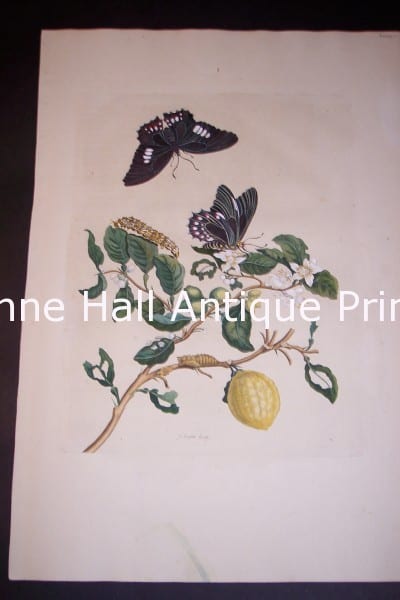
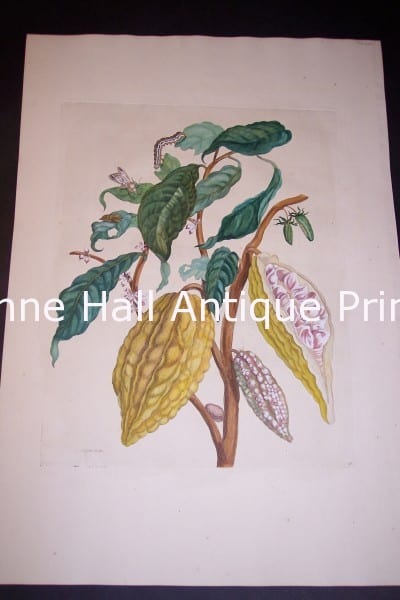

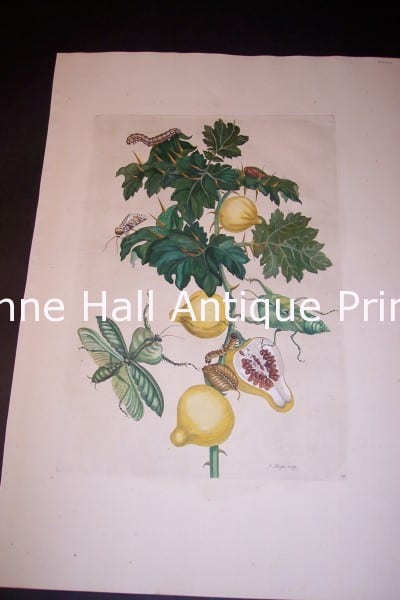

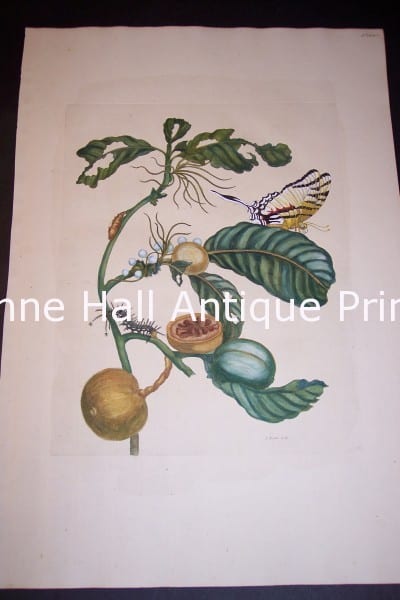
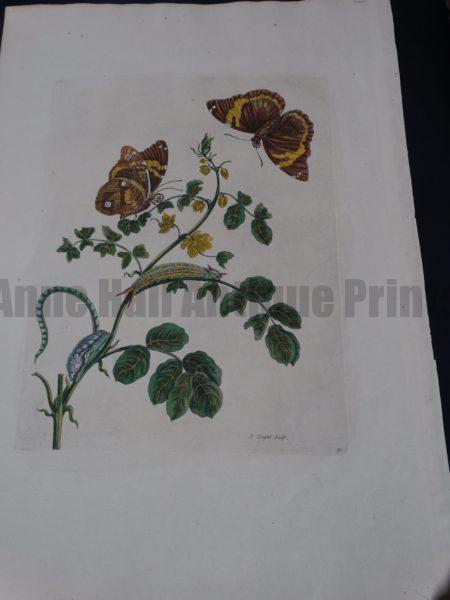
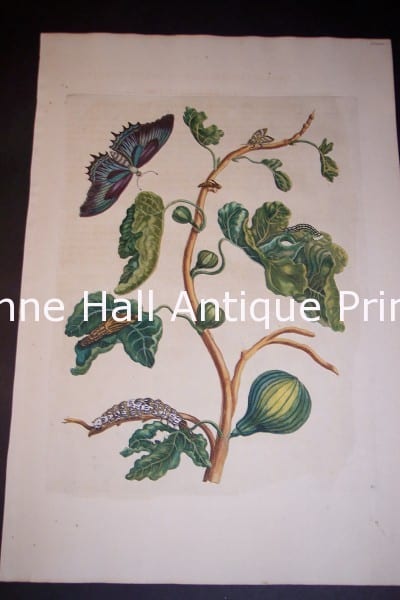

Set of three framed, 300-year-old insect prints: Maria Sibilla Merian’s Insects of Europe.
This extraordinary trio of insect prints showing butterfly transformations & metamorphoses is a set of three framed pieces. The exquisite set of antique rose and caterpillar prints are hand-colored engravings date to 1730 Amsterdam. It is the rare work, of Maria Sybilla Merian, and her Insects of Europe. Her insect prints showing transformations & metamorphosis, are a trademark of her work, on art & entomology. Each piece measures 9×11″ and has been framed with archival materials. Sold as a trio for $1650. Call Anne at 413-245-4197 to place your order. Learn more about Merian at the bottom of this page.
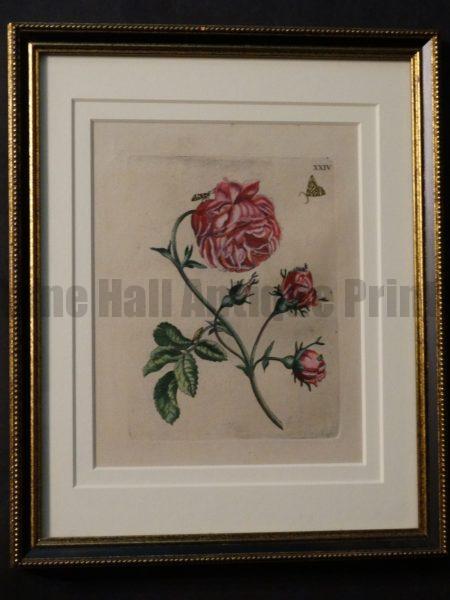
Maria Sybilla Merian Rose 2.
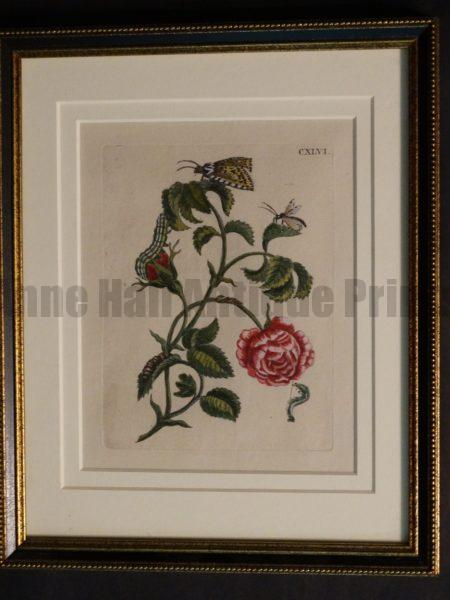
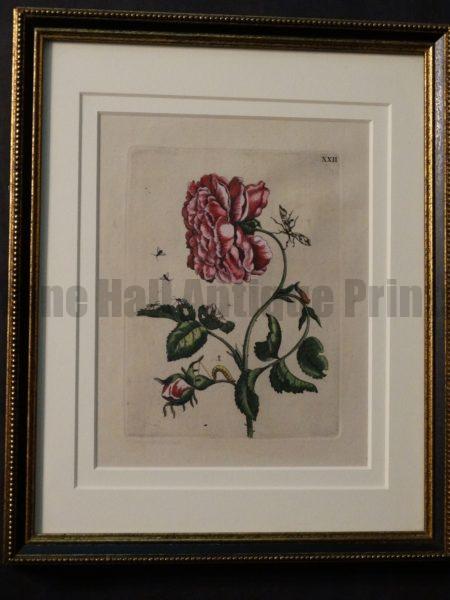
Insect prints, almost 300 years old: a set of 6 Framed, Maria Sybilla Maria, from Insects of Europe, which published in 1730.
Insect Prints-Maria Sybilla Merian. Sourced from her Insects of Europe, published Amsterdam 1730. Merian’s daughters Dorthea & Maria published them. These are hand colored copper plate engravings on hand made hand laid rag. Framed using the finest archival materials, each piece measures 11 1/2 x 12.” The high end molding is dark green and gilt gold leaf. Call 413-245-4197.
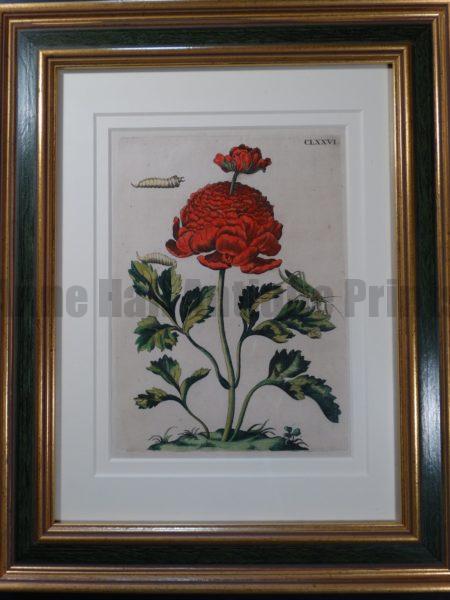
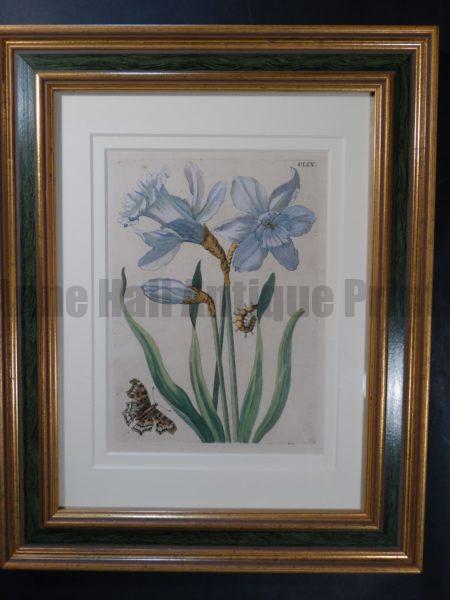
Paperwhite Daffodils.
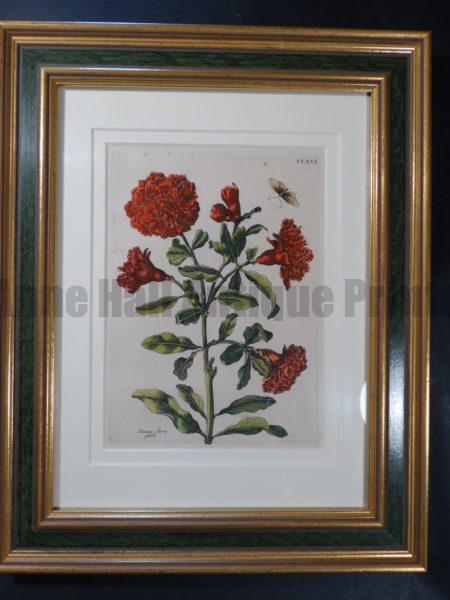
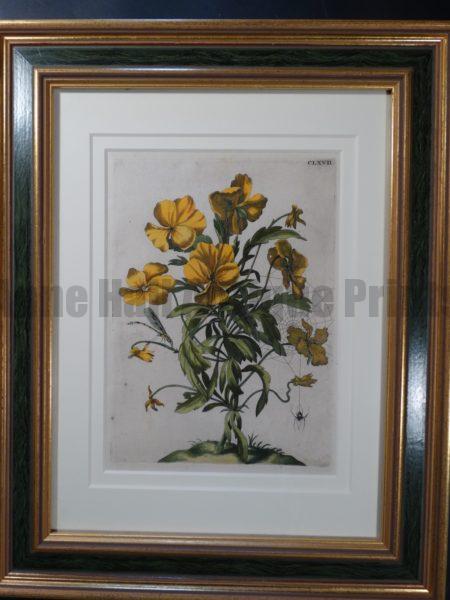
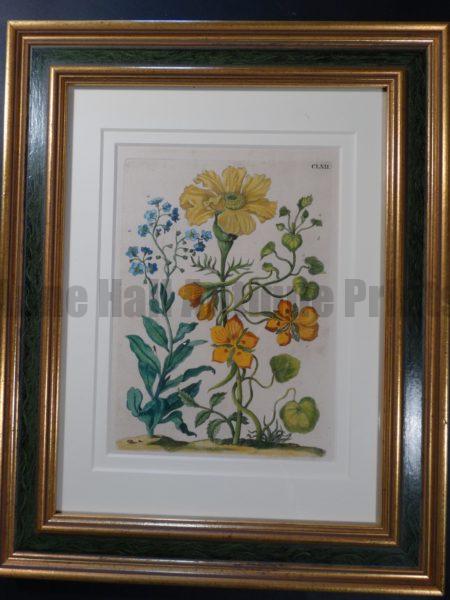
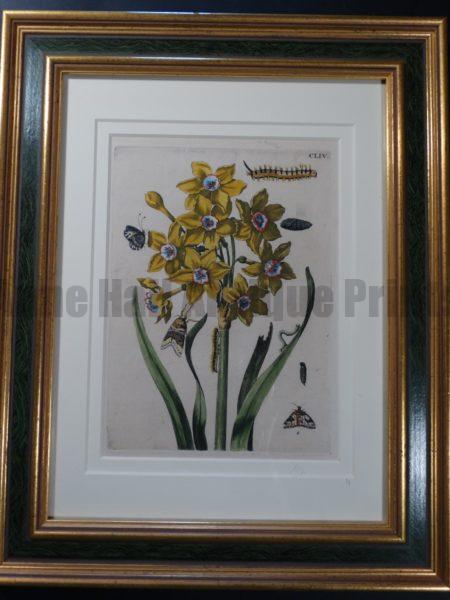
Insect prints metamorphosis: Loose 300 year old bookplates, from Maria Sybilla Merian’s Insects of Europe.
These insect prints showing butterfly transformations & metamorphoses are by Maria Sybilla Merian. She pioneered her theories on the subject & roused medieval thinking once and for all. Each piece is a hand colored copper plate engraving on hand made hand laid linen rag paper from 1730. The small pieces of art, measure @ 7 x 8 1/4.” The prices vary from $150 and up.Click here to contact us.
Would you like to order one of Merian’s European insect prints? Call Anne at 413-245-4197. Or buy them in our online SHOP. Prices range between $200-350. each.
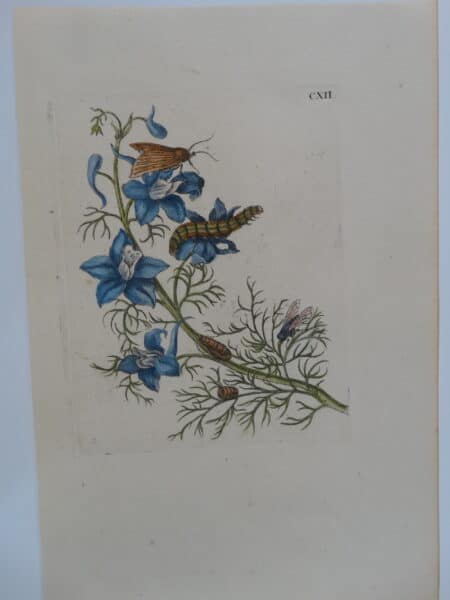
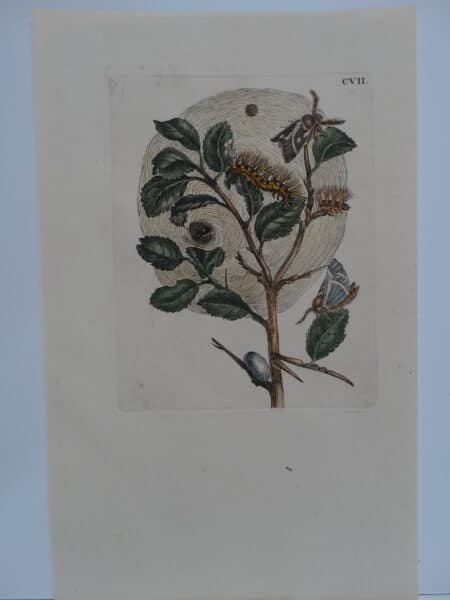
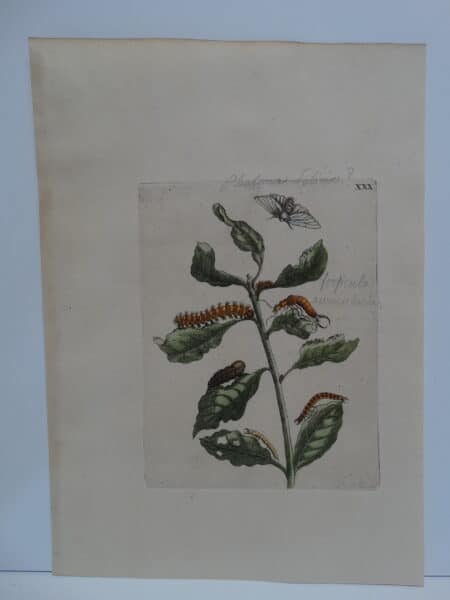
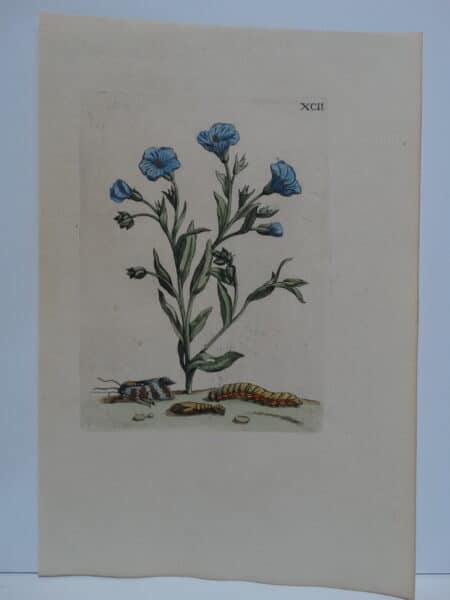
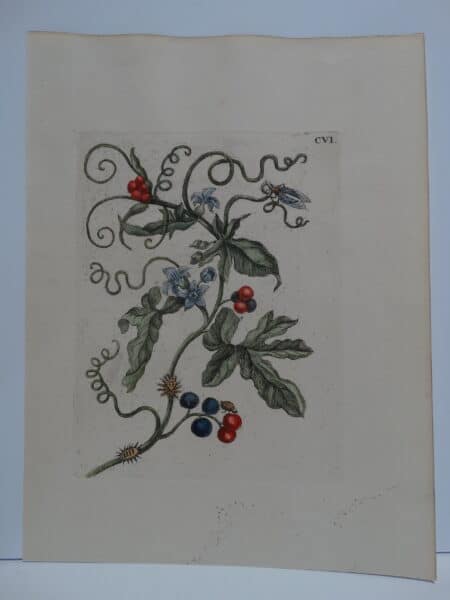
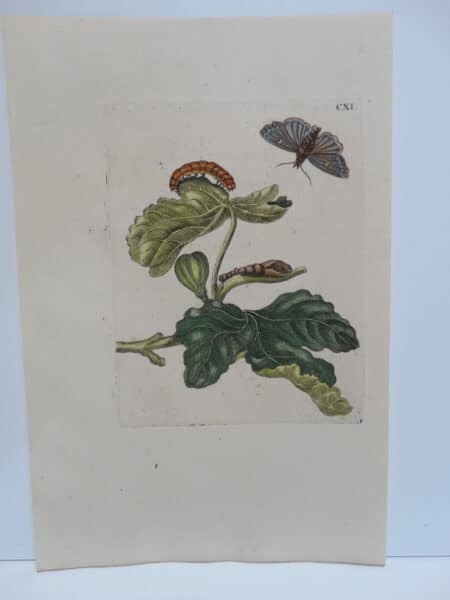
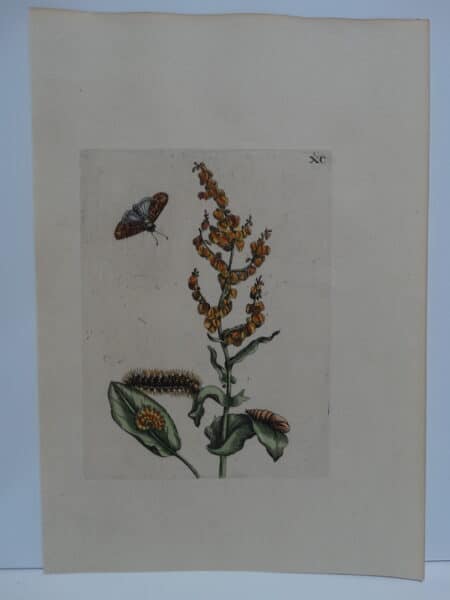
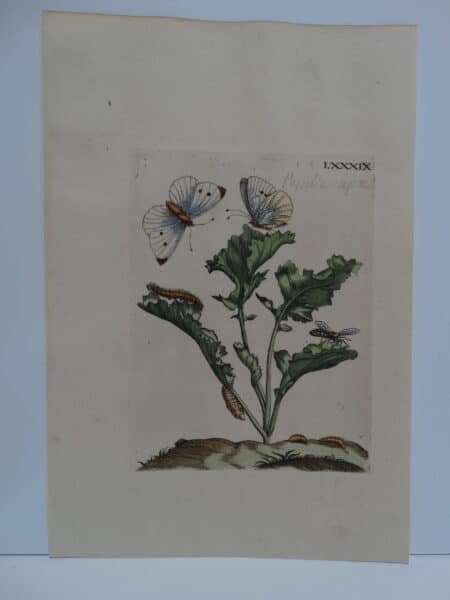
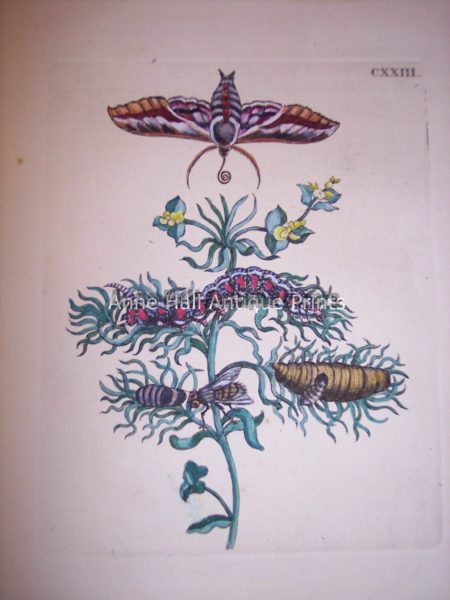
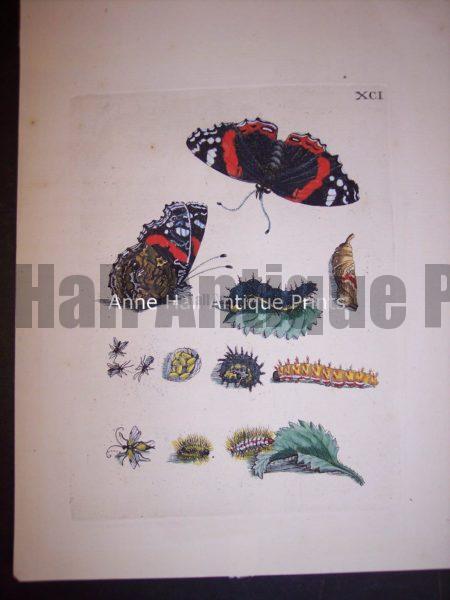
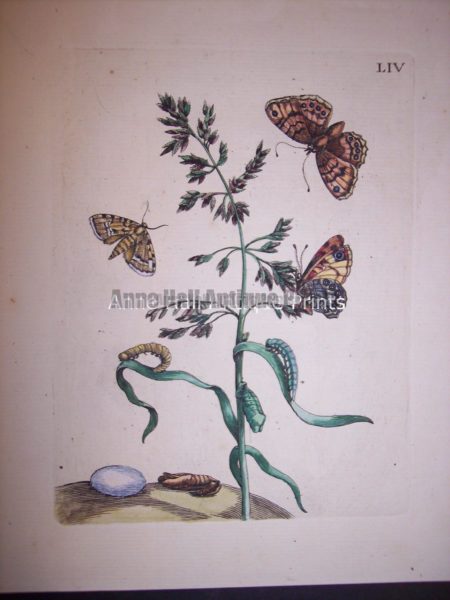
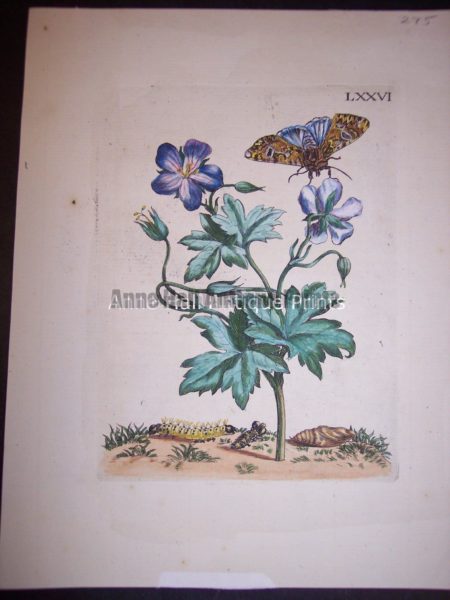
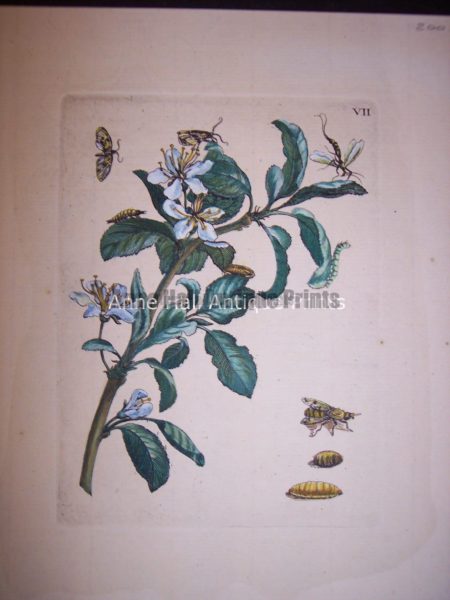
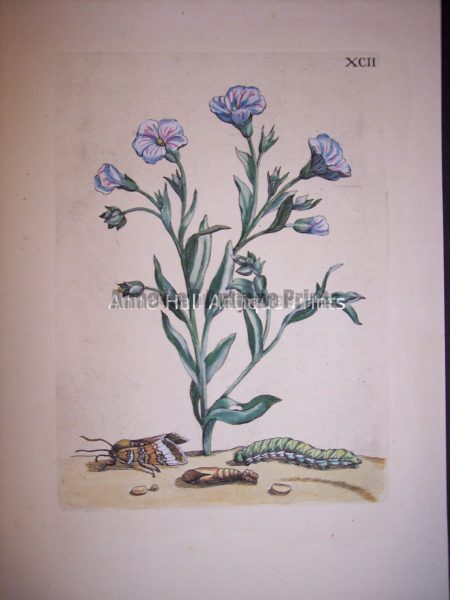
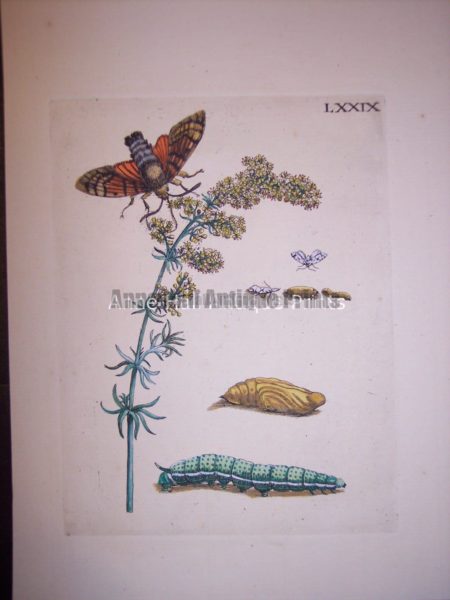
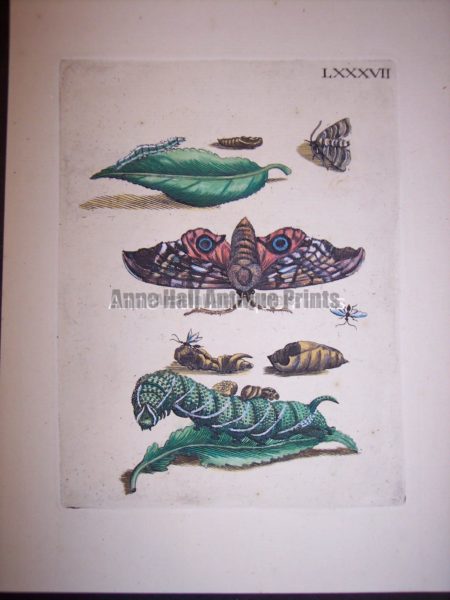
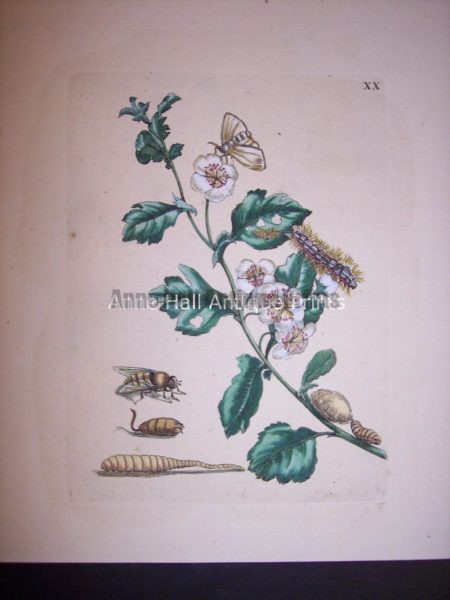
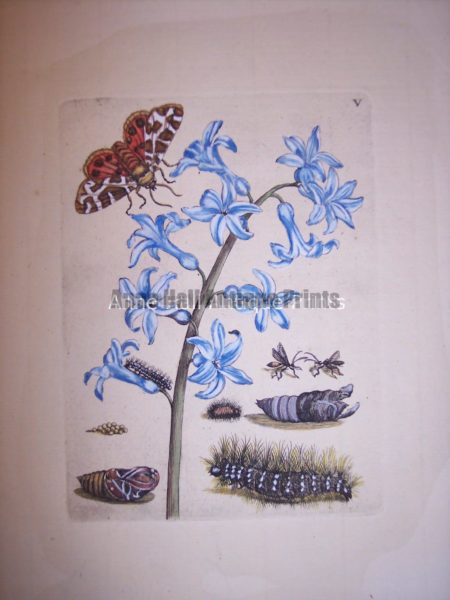
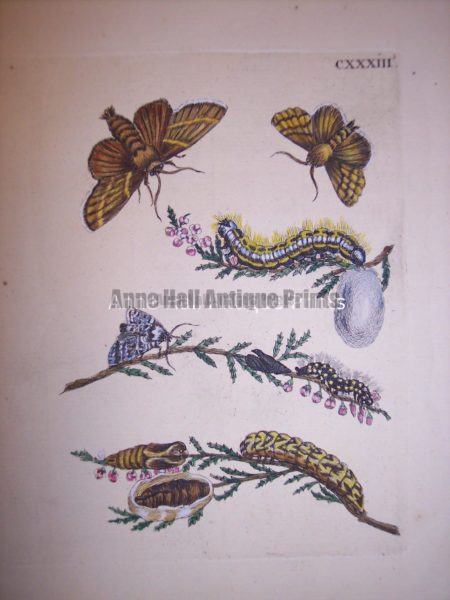
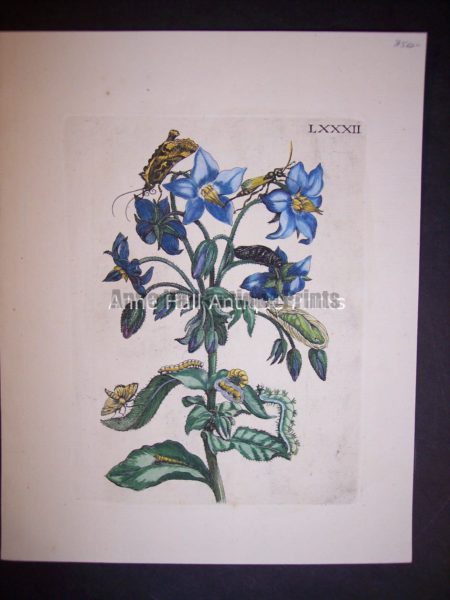
Insects of Europe was revolutionary. Maria Sybilla Merians work, changed Medieval thought forever.
Insects Prints from Insects of Europe by Maria Sybilla Merian. It was a revolutionary work on European Entomology. Ours published Amsterdam 1730. Maria Sybilla Merian was the first person, a pioneering woman, to explain through these stunning illustrations. The depictions are of the transformation & metamorphoses of butterflies, moths and other insects. Merian’s work on butterflies and moths on Insects of Europe was revolutionary. It changed Medieval thought forever.
Maria Merian lead this significant discovery. She proved the stages of the transformation to the male dominated world of science. Up to this time, it was thought that butterflies were birthed from various sources. Rather than morphing from a cocoon or pupa. She was enthralled with insects at a young age. Young Maria collected and studied them. Women were not allowed to work in oils, only men were permitted so she worked in water colors. Another huge influence on her life’s passion for creating the insect prints was her step father. He was a famous publisher named Mathias Merian.
Conclusion: Merian disproved Medieval thought forever.
Merian is considered one of the most significant contributing artists to document the developmental stages of insects. She devoted her life to Entomology, the branch of zoology dealing with insects. She also worked as a botanical artist portraying insects with their host plants. Maria Sibylla Merian described the life cycles of some 186 insect species. Most importantly, she recorded the transformations and metamorphosis of insects, moths and butterflies she saw. In five words: Merian disproved Medieval thought forever.
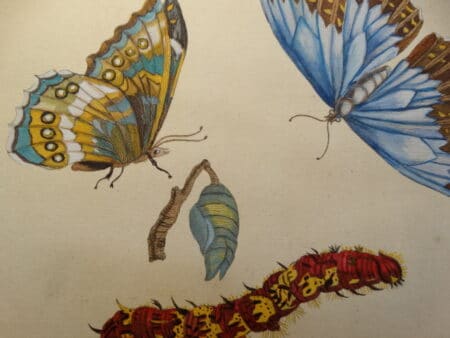
Learn more about Maria Sibylla Merian: An Essay by Christina Clarke of Williamsburg Virgina.
Written February 9, 2015 for the use of Anne Hall Antique Prints. My friend, Christina Clarke of Williamsburg, Virgina is also captivated by Merian as an entomologist, artist and woman. So she wrote this essay on her and has allowed me to publish it. Christina finds her insect prints showing the transformations & butterfly metamorphosis by Maria Sybilla Merian uncomparable to any 17th century artist. Let alone the implications of a woman, female artist which was unheard of 300 years ago. That world was reserved for men in the male dominated times. I appeciate Christina’s passion, as she does mine. We have had many exciting conversations about Maria Sybilla Merian and her extraordinary life.
April 2, 1647 – January 13, 1717 This remarkable woman is considered to have been one of the most significant contributors to the developmental stage of the field of entomology (a branch of zoology that deals with insects). She was a life-long dedicated entomologist. She also worked as a botanical artist, portraying insects with their host plants and painting flowers. Maria Sibylla Merian described the life cycles of 186 insect species. Her specific area of interest, in the metamorphosis of insects, was the life cycles of moths and butterflies.
The Merian Family History and its Impact in the 17th Century
Matthaus Merian the Elder, was a painter and engraver in Switzerland, France, and Germany. In 1646, a year after the death of his first wife, Merian the Elder married Johanna Sibylla Heim, whose heritage was Dutch. Maria Sibylla Merian was born to the couple a year later, in Frankfurt, Germany, in 1647. Her father died when she was three years old. In 1651, her mother married Jacob Marrel, a German flower/still-life painter and art dealer, who was a widower with three young children. They lived in Frankfurt, Germany, where Jacob Marrel established a workshop and had two apprentices for instruction in drawing, painting and engraving. He and Maria Sibylla Merian developed a unique relationship. Marrel introduced Maria Sibylla to the art of miniature flower painting, against her mother’s will. Maria Sibylla secretly began to teach herself to draw and paint. Studying alongside Marrel’s male pupils, she learned how to draw, mix paints, paint in watercolor, and make prints.
By the age of 11, she could engrave a copperplate. Beginning at age 13, when Maria Sibylla observed the metamorphosis of a silkworm, her documentation of nature continued for more than 50 years. She was enthralled with the raising of caterpillars “in glass jars, wooden boxes covered with gauze, in her attic and cellar” (Reitsma, 2008, p. 25). She was especially interested in capturing and raising caterpillars, to observe and document their life cycles. Maria Sibylla was tenacious in her collection and raising of thousands of caterpillars, over decades, and documenting their life cycles, i.e., drawing and describing them with careful attention and accurate details.
Maria Sybilla Merian: Artist, Entomologist, Author, Wife and Parent
Johann Andreas Graff (1636-1701) was her step-father’s favorite pupil. Maria Sibylla and Johann A. Graff were married when she was 18 (1665). Johann was near 30 years old and was a publisher. They moved to his native Nuremberg in 1668. As a woman, Maria Sibylla Graff was prohibited from selling oil paintings, but was permitted to paint in watercolor on vellum. She taught embroidery and painting to the daughters of respected citizens in Nuremberg. The Graffs had two daughters, Johanna Helena (born 1668) and Dorothea Maria (born 1678). While in Nuremberg, Maria Sibylla began her prodigious publication of books on flowers and caterpillars. In 1675, the first volume (of three) of Neues Blumenbuch (New Book of Flowers) was published, by Johann’s publishing company. Each volume had 12 flower plates.
Der Raupen wunderbare Verwandlung und sonderbare Blumen-nahrung
In 1679,Volume I, of her 3-volume book, Der Raupen wunderbare Verwandlung und sonderbare Blumen-nahrung (The Wondrous Transformation and Singular Plant Nourishment of Caterpillars) was published in German through her husband’s company. This publication illustrates the metamorphosis of caterpillars, against the background of their host plants. It was the first work in history to link art and entomology. In the preface of this phenomenal publication, Maria Sibylla states that she wrote it as a means of worshiping God (Reitsma, 2008). Also known as The Caterpillar Book, it was also published in Frankfurt in 1683 and posthumously, in Dutch, in Amsterdam in 1717. About 1686, Maria Sibylla left her husband. They later divorced, in 1692. She dropped Graff as her last name, and was thereafter known as Maria Sibylla Merian (her birth name). She, her two daughters, and her elderly mother, moved to a religious sect community known as Labadists, near Amsterdam, The Netherlands. While there, Marian developed a fascination for the tropical plants brought to the religious community by fellow Labadists, from their Suriname plantations in South America. In 1691, following the collapse of their religious community and the passing of her mother, Merian and her daughters moved to Amsterdam. Merian and her daughters, both of whom learned the skills of art from their mother, established a studio in Amsterdam. They painted birds, insects, and flowers. Merian had maintained contact with some of her Labadist acquaintances, and knew there was a Labadist plantation, in the Dutch colony of Suriname (AKA Surinam), on the northern coast of South America (Dutch Guiana).
Insect Prints by Moses Harris | Aurelian published London 1796
Moses Harris’s uncle was a member of the first organized Society of Entomologists in England, called the Society of the Aurelians, or Butterfly Society. He encouraged Moses to learn about insects as a child. After a massive fire at the Society, all the collections were lost. 14 years later, in 1762, Moses Harris became the secretary, of the second Society of Aurelians.
In 1776 Moses Harris published the Natural System of Colours. He furthered Sir Isaac Newton’s work on color, developing the color wheel which we still use today. Newton passed away in 1727 (born in 1643). It was nearly 50 years before Harris developed the color wheel.
Available plates from Aurelian, published London 1796, by Moses Harris
The beautiful watercolor, copper plate, engravings are about 220 years old. The paper heavy wove rag with intense complementary colors. Decorative compositions of transformation and metamorphosis stages in butterflies. Each piece measures 10 1/2 x 14 1/2″ and are demonstrative of Harris’s life long passion.
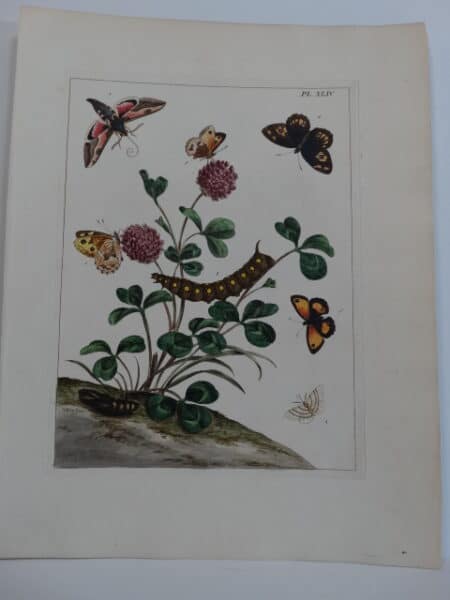
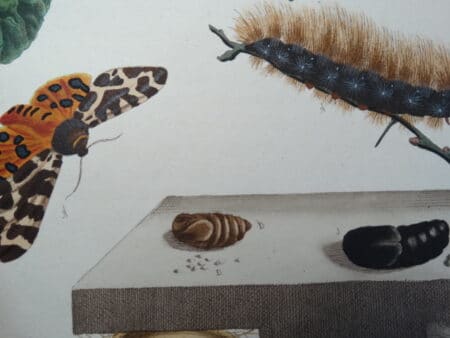
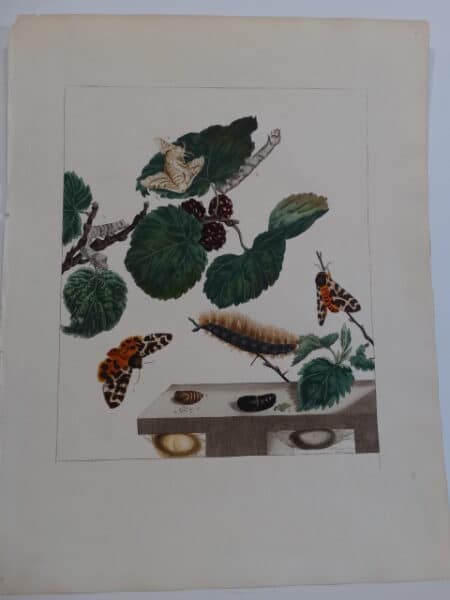
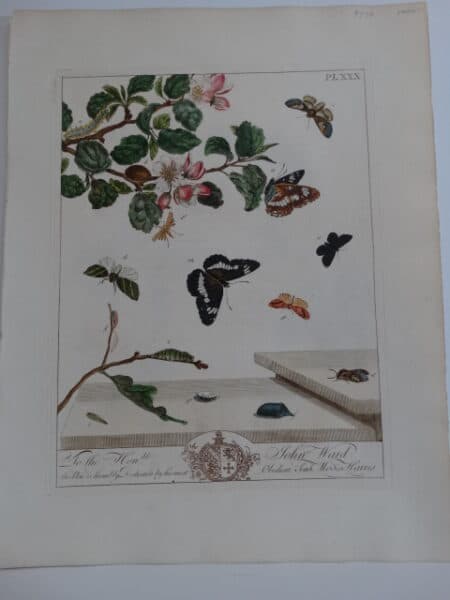
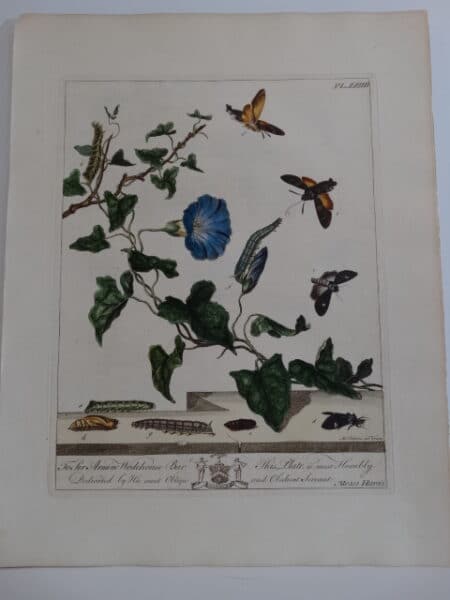
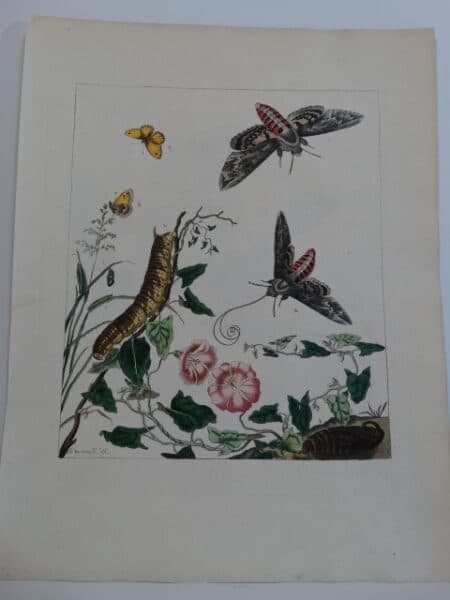
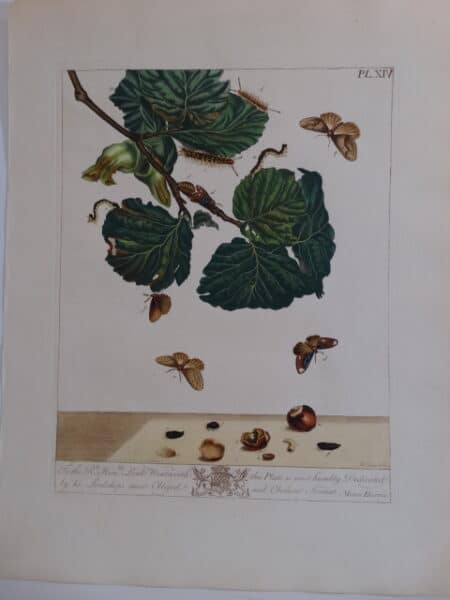
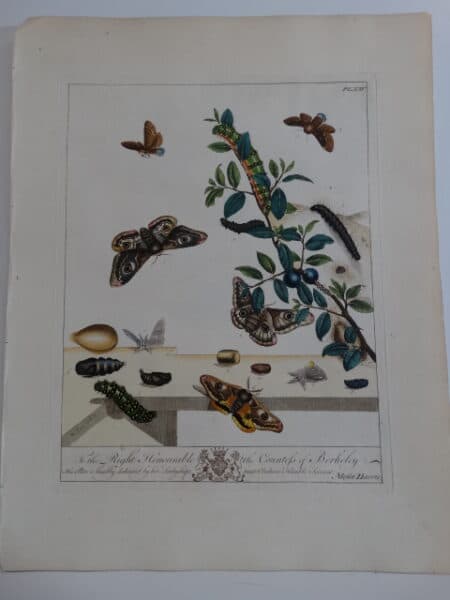
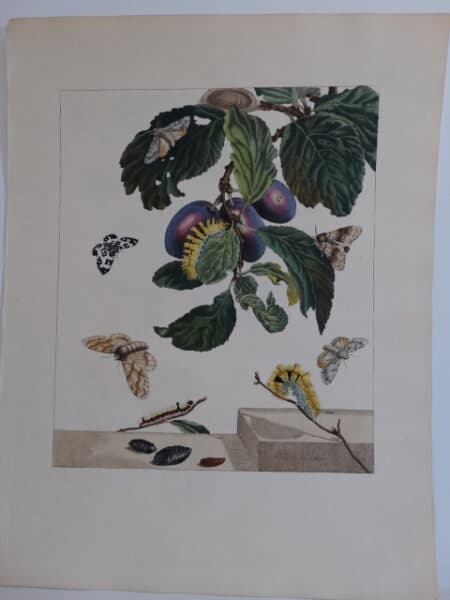
More available pieces, Moses Harris Aurelian, watercolor engravings from 1796.
Insect Prints showing transformations & butterfly metamorphosis. Moses Harris Aurelian. Hand Colored Insect Prints. These beautiful old butterfly prints are the work of Moses Harris, coming from his great work on Butterflies entitled The “Aurelian.” These are gorgeous, water colored engravings on hand made rag. These Butterfly Prints were produced in England in 1796, by Moses Harris – Chief of the Lepidoptera Society (or Butterfly Society). He was an EXPERT ON COLOR, first to illustrate the color wheel we use today. The old engravings mat up perfectly to 16 x 20″ while the paper measures 12 14 x 16″. Click here to contact us.
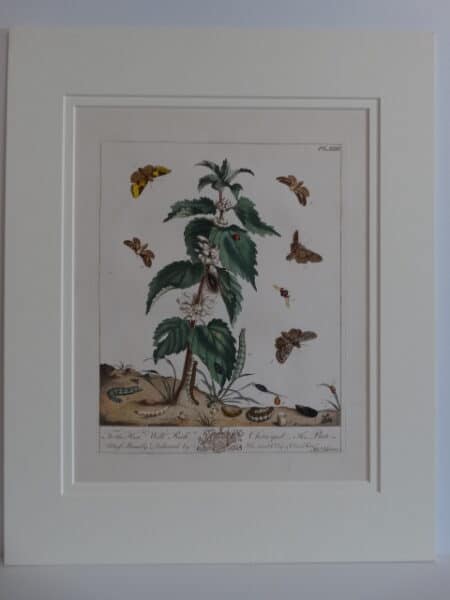
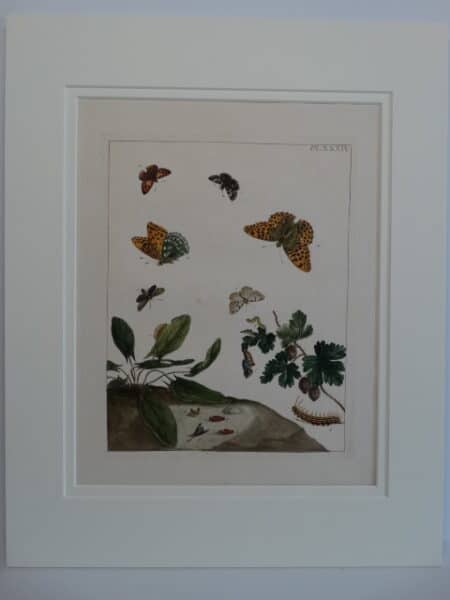
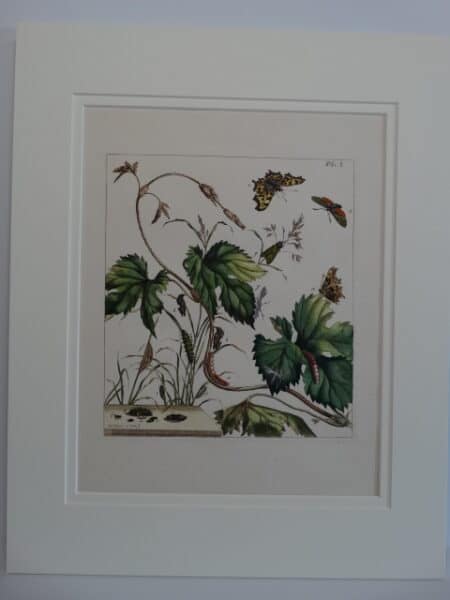
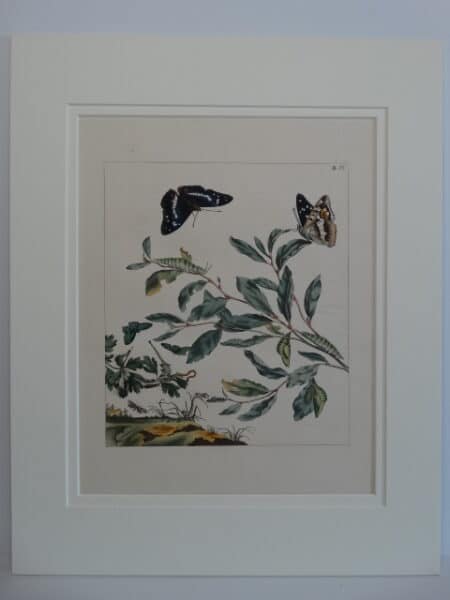
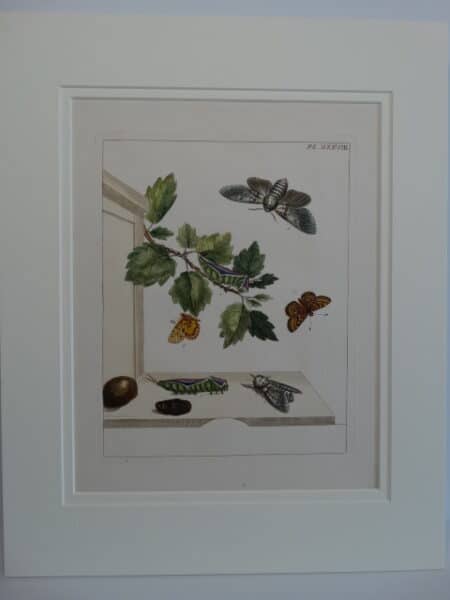
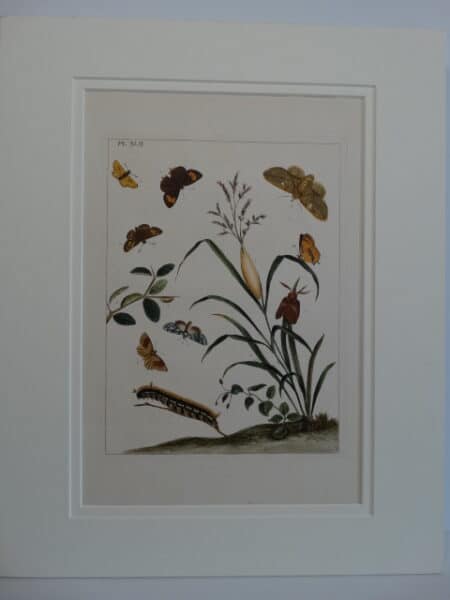
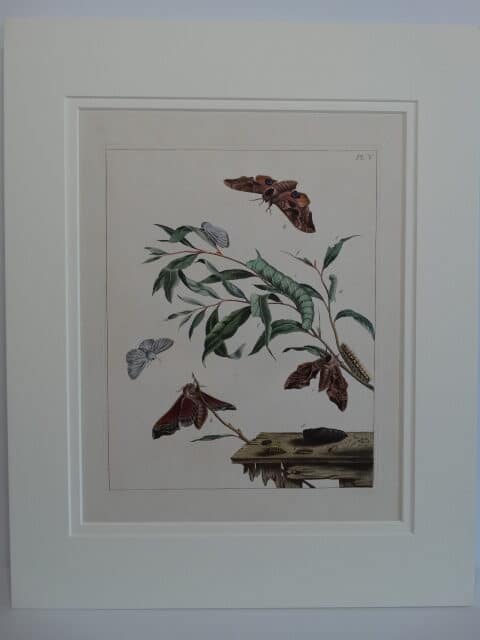
Set of three Antique Insect Prints: American Lithographs of Butterflies from 1885, Gold Bamboo Frames.
Louis Prang is known the “father of American chromolithography.” It is an obsolete 19th century printing method. In the process, each and every color seen was applied in sequence, with individual, key stone limestone plates. The plates are called lithographs. A certain kind of limestone came from a certain quarry in Germany. It had the exact porosity to become a lithograph. The process of chromolithography was utilized in America from about 1850-1910. Deemed too laborious to use once photo mechanical printing began.
A wonderful trio of antique entomology lithographs. The set shows the transformation, or different stages in the butterfly and moths. This set of three, American 19th Century insect prints, published New York in 1885. First class archival framing. The horizontal piece should be placed in the middle, when hanging vertically or horizontally. Each piece measures 13 x 16.” Sold as a set of three $775. with free US shipping. Call 413-245-4107 to place your order. Or email: anne@annehallantiqueprints.com.

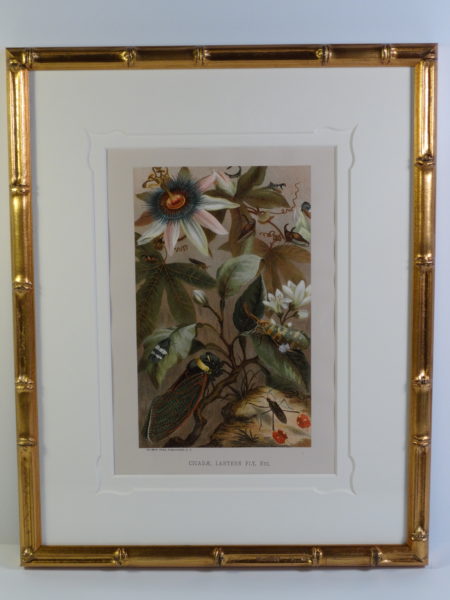
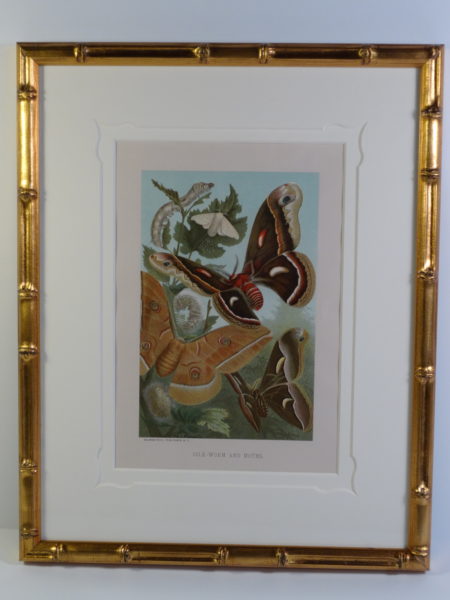
This trio (three) 19th century antique prints boasts of butterflies and other insects in their natural environments. The set of three is framed in gold leaf bamboo over red paint. Each piece has been personally framed by Anne using archival materials. The natural history books published New York in 1885. Printed in colors by the lost art of lithography. An antique printing method or process in which each and every color was applied by a keystone limestone plates. I have framed them in double rag matting and completed the with UV glass. Each measure 13×16.” Sold in a set of three for $775. shipped. Click here to buy now. Click here to contact us or call 413-245-4197.
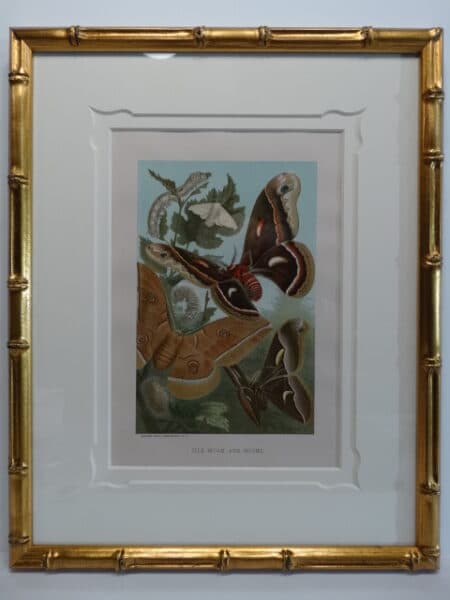
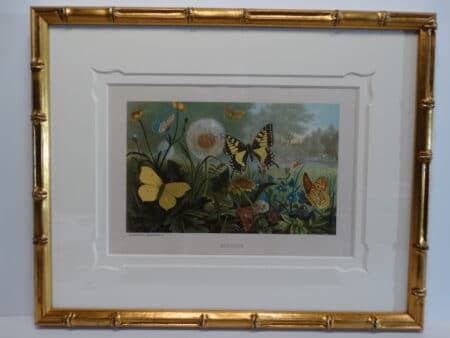
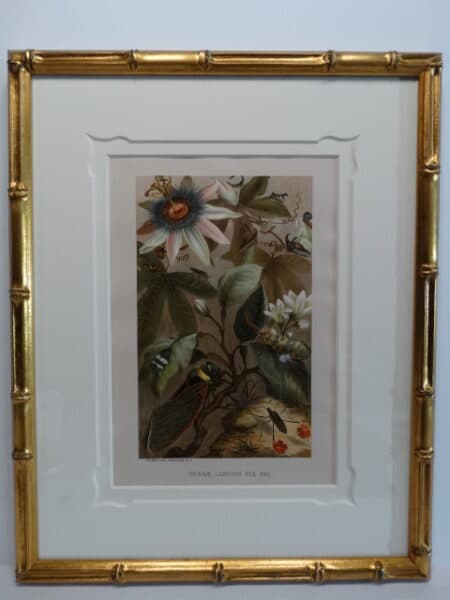
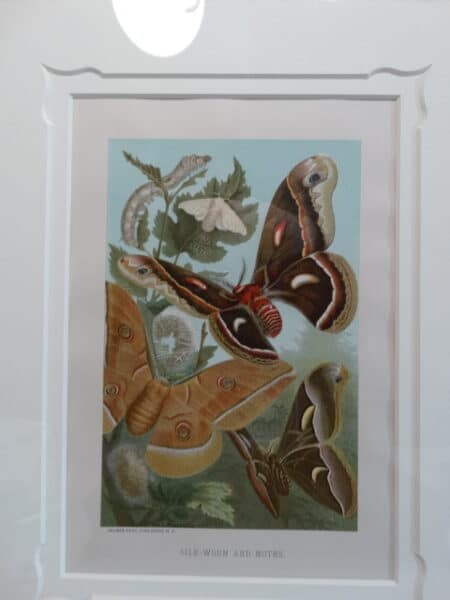
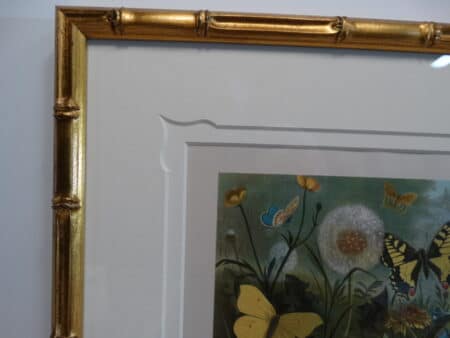
A pair of moth butterfly engravings with watercolors from 1790.
Set of two, 230 year old engravings, of butterfly & moth. German watercolor engravings from 1790. Laid paper. Excellent condition. Strong colors. Each piece measures 8 x 9 1/2″. $350 for the pair.

George Edwards, 18th century, insect prints of butterflies and birds.
A pair of watercolor engravings which date to 1748-1770. Printed in the 18th century. The bookplates published in Nuremberg and Amsterdam. George Edwards and Dr. Seligmann were the authors. Each piece measures 10 1/2 x 17″. Priced and sold as a pair for $500.
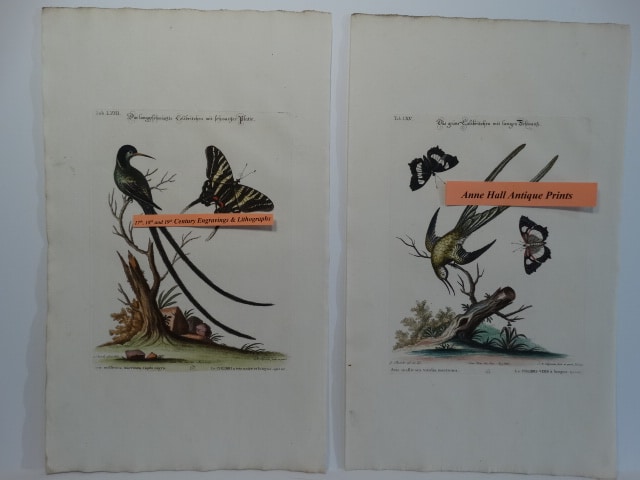
Hand-colored butterfly engravings, set of three, framed using archival materials.
This set of three antique engravings have original watercolors. The c.1800 butterfly engravings are over 100 years old, ready to hang. Archival framing were used including UV Glass. Framed in 3/4″ walnut burlwood picture frame.s The 2 larger pieces measure 13×16, and one smaller measures 11 wide x 9 high. A perfect trio. Set of three $775. with American shipping. Click here to contact us.
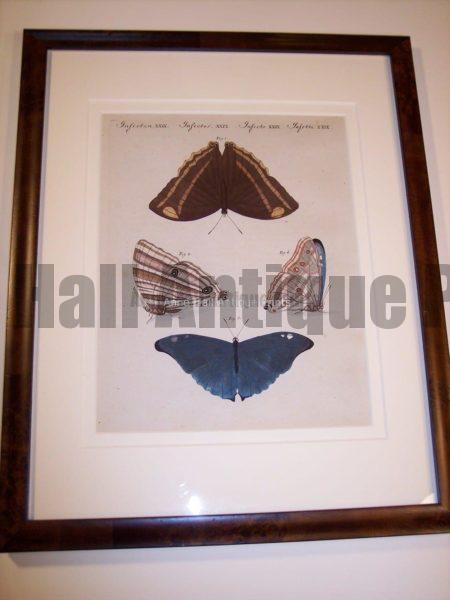
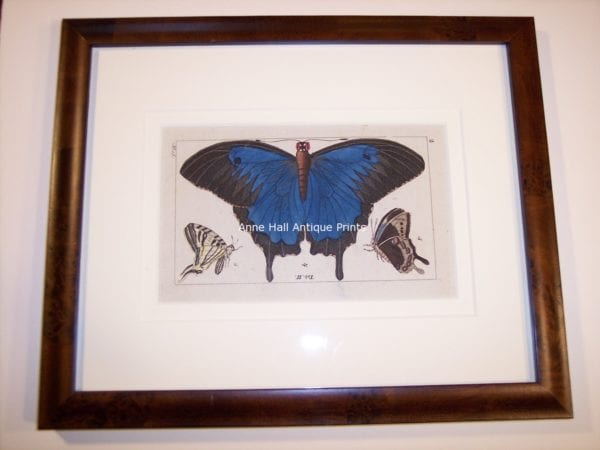
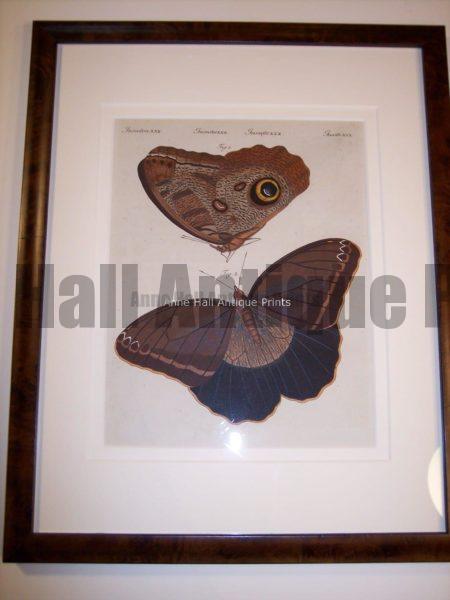
JJ Schmuzer Insect Prints: Miniature watercolor engravings from c.1805.
Insect prints showing butterfly transformations by JJ Schmuzer published c.1805 in Vienna, Austria. Small size, just measuring in at 4 1/2 x 7 1/2.” German hand colored copper plate engravings on hand made rag. Wonderful transformation stages of butterflies, caterpillars, moths, pupa, dragon flies and other bugs. An entomologists dream come true! Click here to contact us.
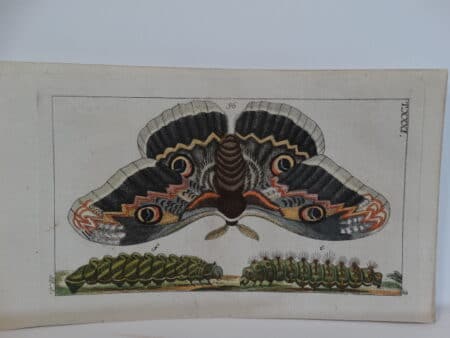
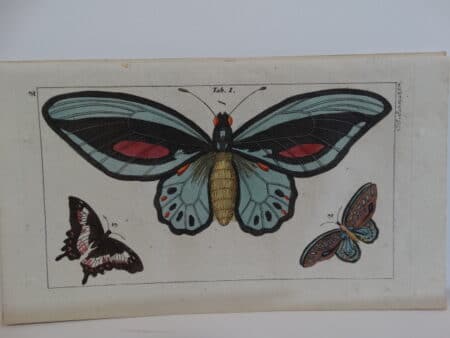
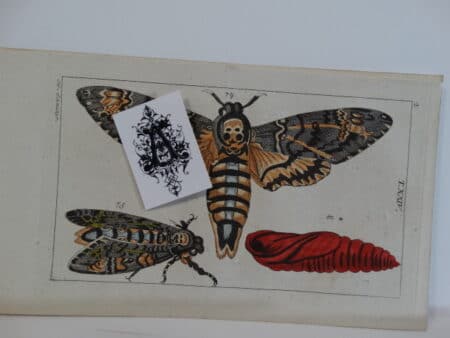
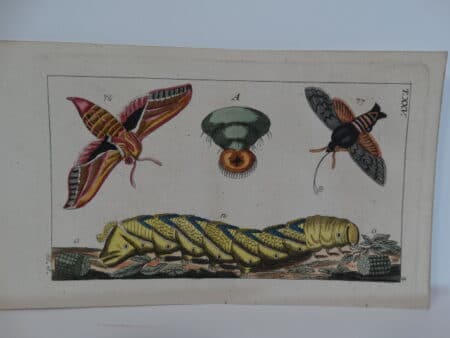
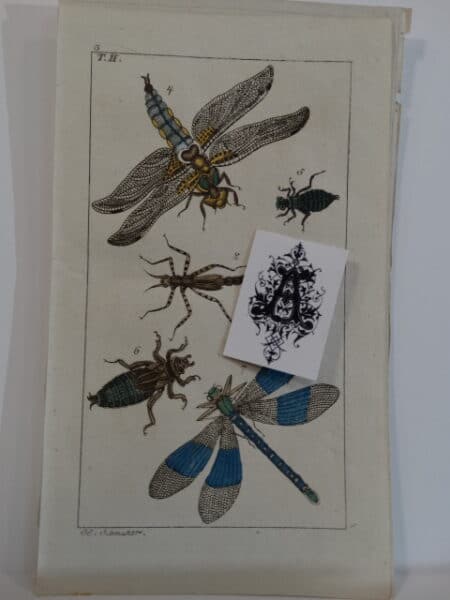
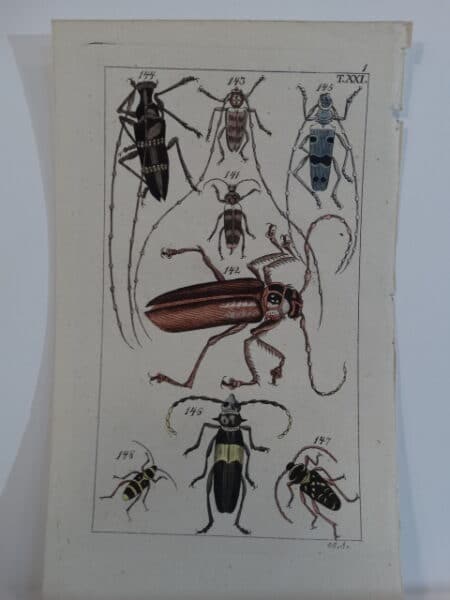
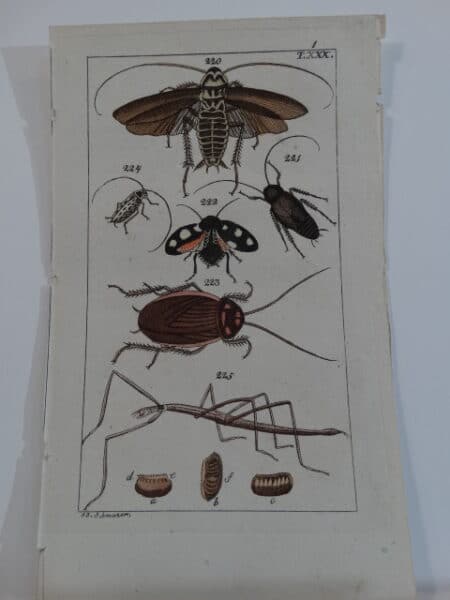
TXXX $40.
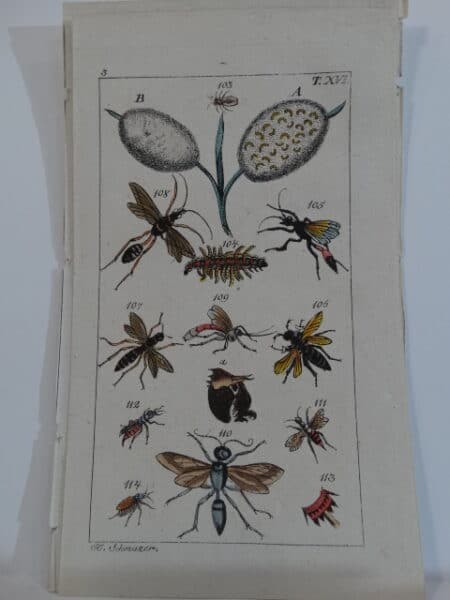
Baron Cuvier Entomology Prints: 19th Century Engravings of Bugs
Insect prints showing butterfly transformations, moths and beetles. Baron Cuvier early 19th century entomology engravings. Books were published in 1805 in London, England and Edinburgh, Scotland. These are black & white English copper plate engravings on rag paper. They are antiques and are nearly 220 years old. Each old engraving measures 6×9″. $50 each.
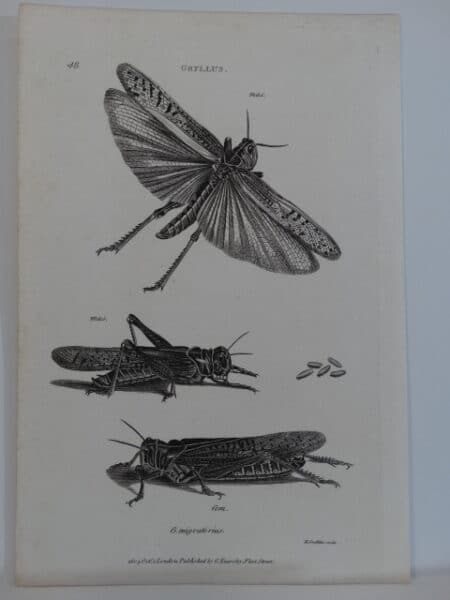
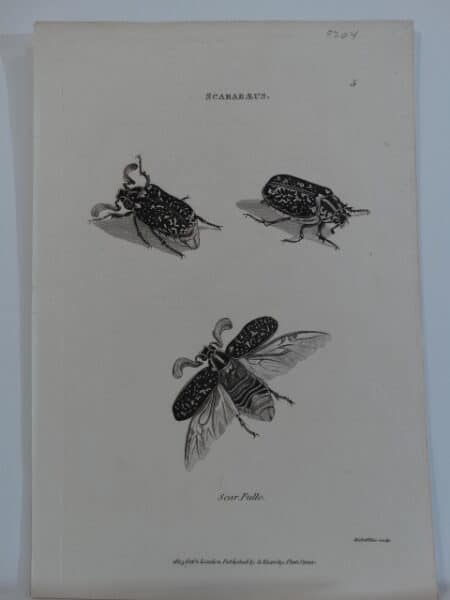
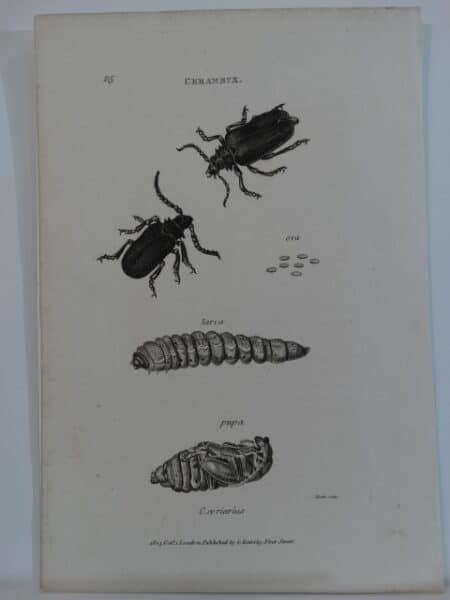
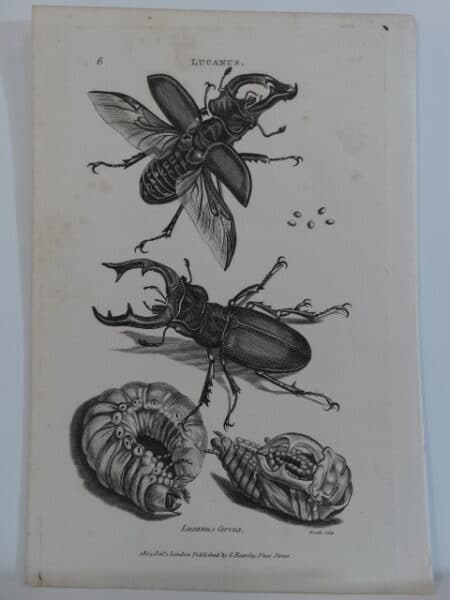
Set of four Cuvier insect prints, circa 1805 engravings, are double matted in rag to 11×14″ and are ready to frame. $275. shipped in America
Shubert Insect Prints: Hand-Colored Engravings from c.1875.
Shubert Insect Prints. Hand-colored, entomology, wood engravings. They published in Germany c.1875. Hand-colored with watercolors, when published in the 19th century. All of the insect prints, show butterfly & moths. Some illustrate the insects’ transformations. Caterpillar, Larve Pupa and butterfly and/or moth. Multiple species are shown in each depiction. Each piece measures 13 1/2 x18 1/2″. 1 or 2 are priced at $95. each. 3 or more $75. each. Look with care, some smudging but overall, very good condition with bright colors… Click here to contact us.
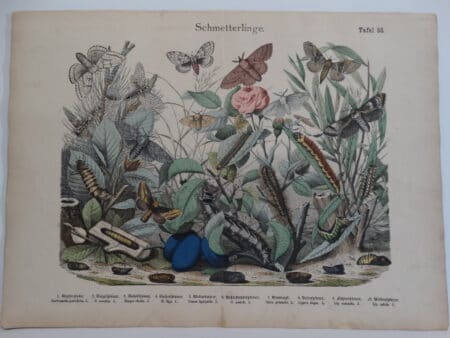
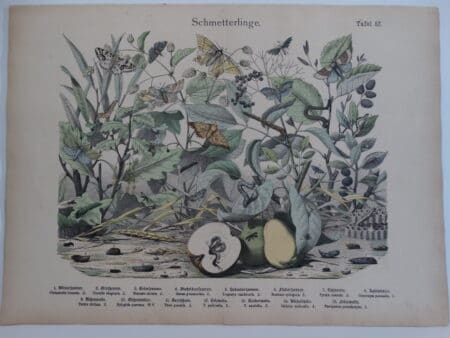
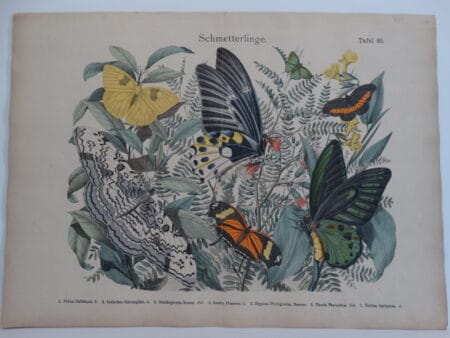
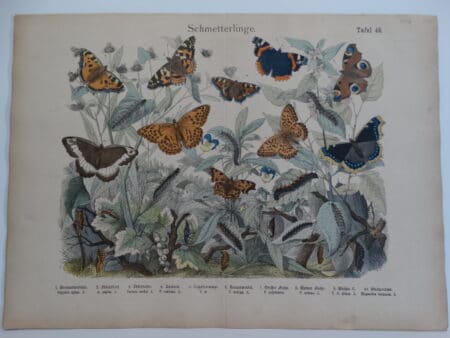
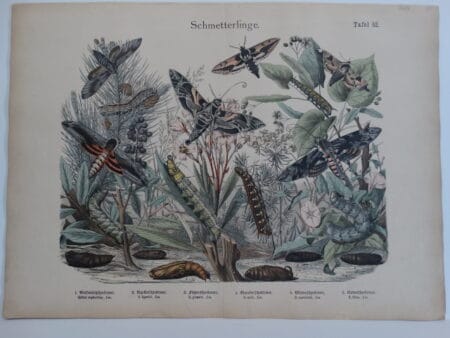
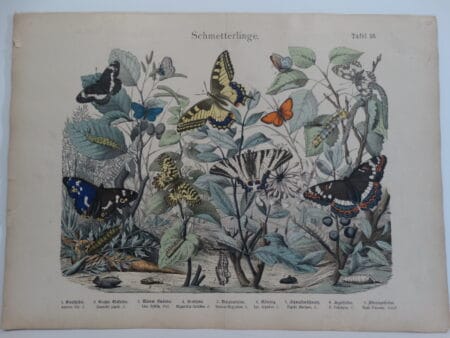
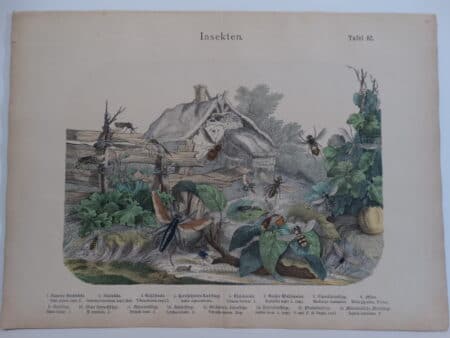
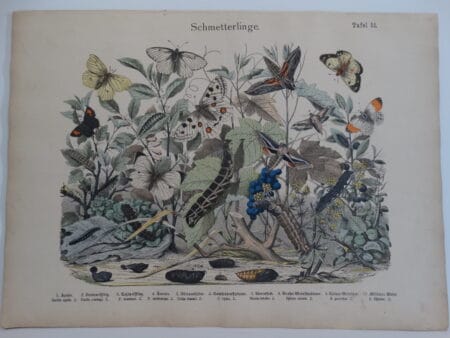
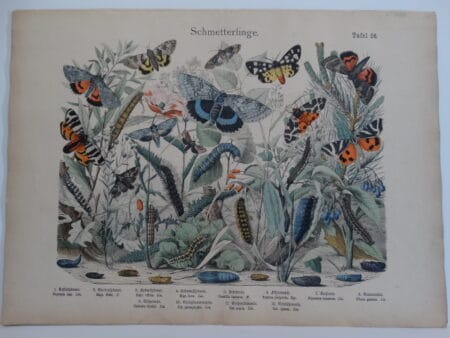
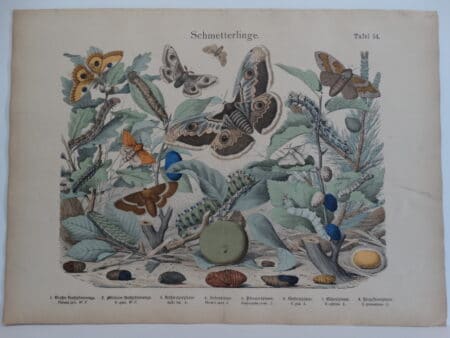
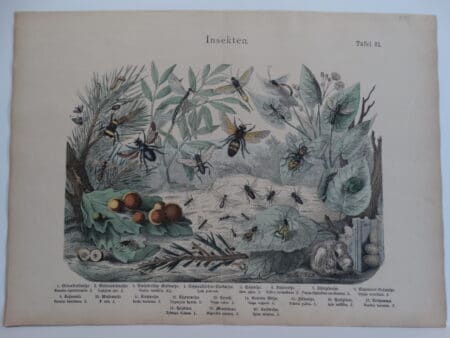
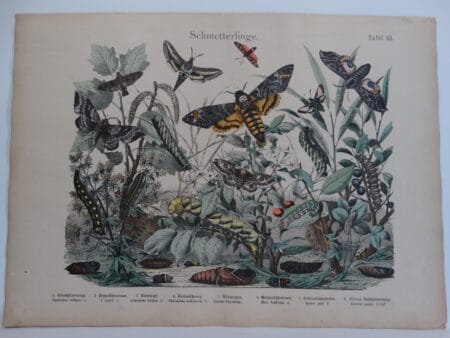
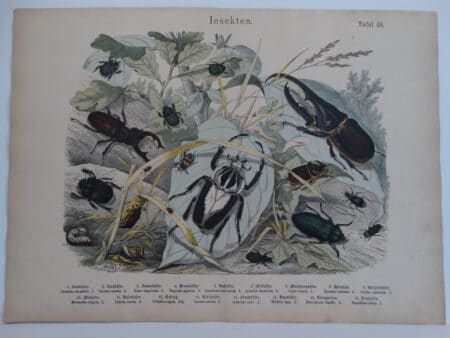
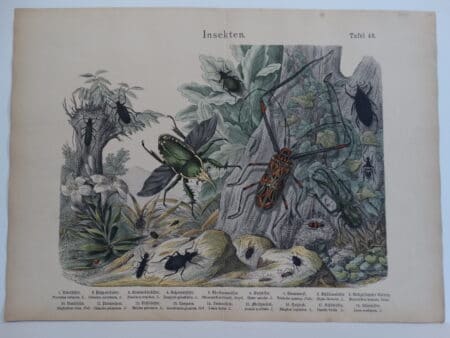
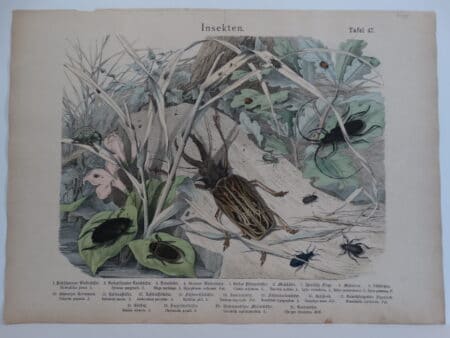
Oliver Goldsmith Entomology. Antique Insect Prints of Beetles, 1850.
Oliver Goldsmith Entomology. Old insect prints from the 1850’s. Watercolor engravings. Our antique prints, are sourced from old books. Each piece showing butterflies and Beetles. 19th Century, Hand-Colored Engravings. Published in Edinburg, Scotland. Each piece measures 6 1/2 x 10″. Call 413-245-4197 to order.
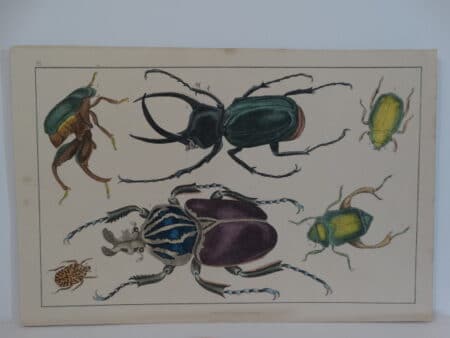
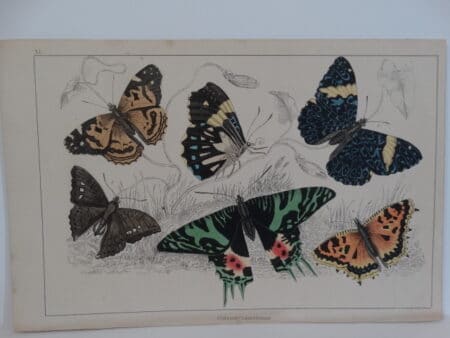
Plate XL $60.
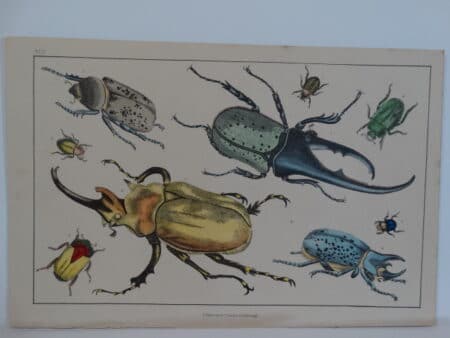
Original Humphrey Insect Prints, or hand-colored lithographs, from 1865.
Published in England, 1865, Humphrey insect prints with butterfly transformations. They are hand colored antique lithographs, about 150 years old. In good condition and measure about 8×11″ Call 413-245-4197 to place your order. $40 each with discounts on sets.


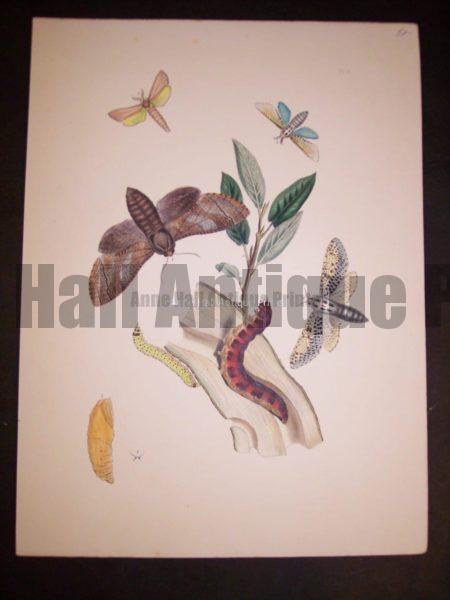
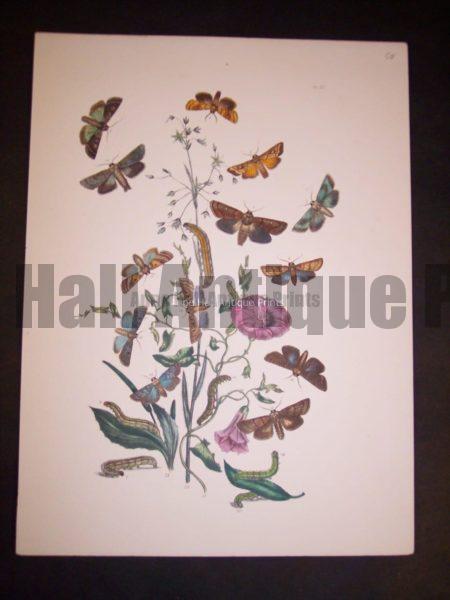
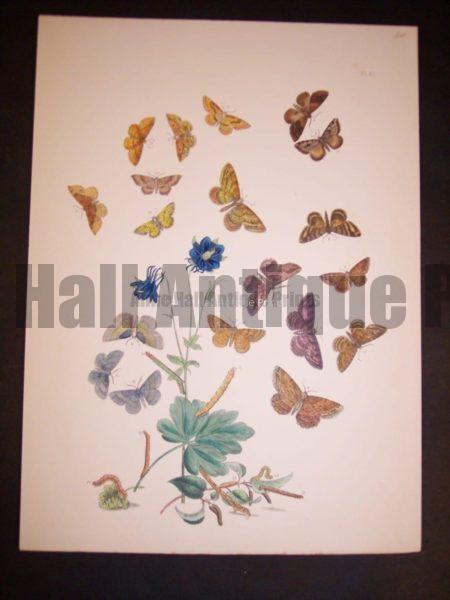
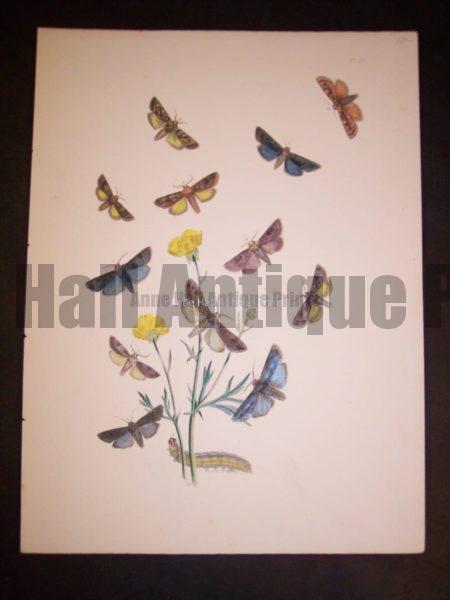
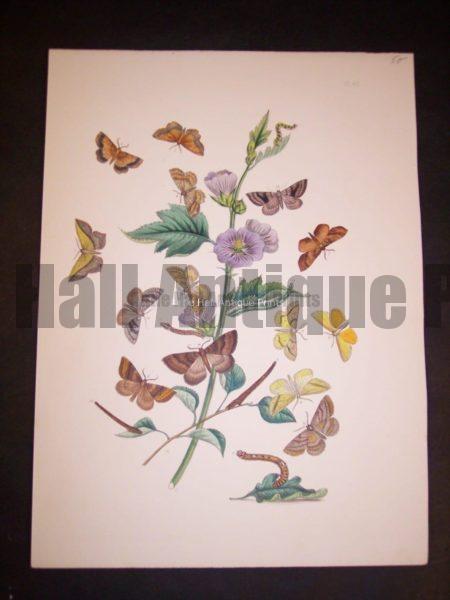
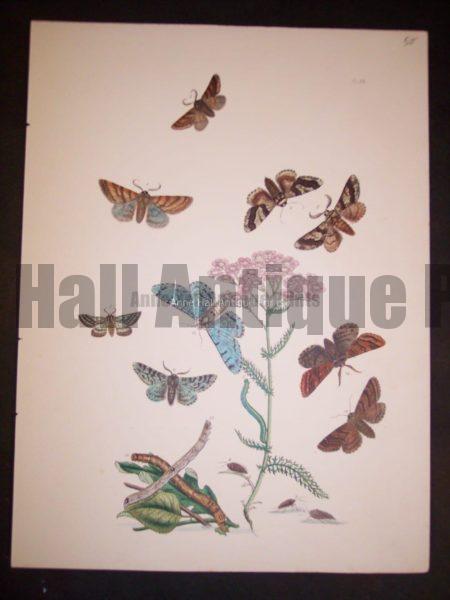
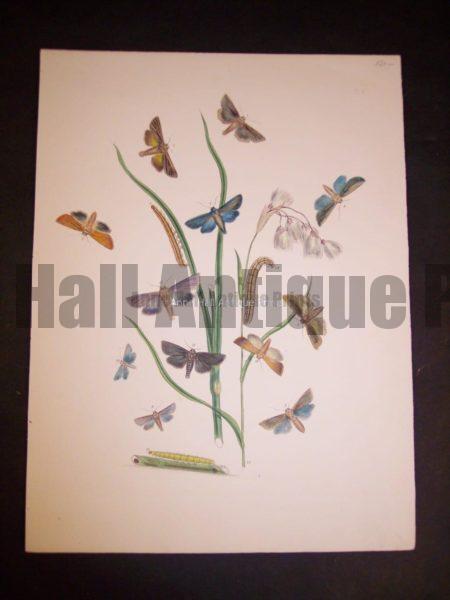
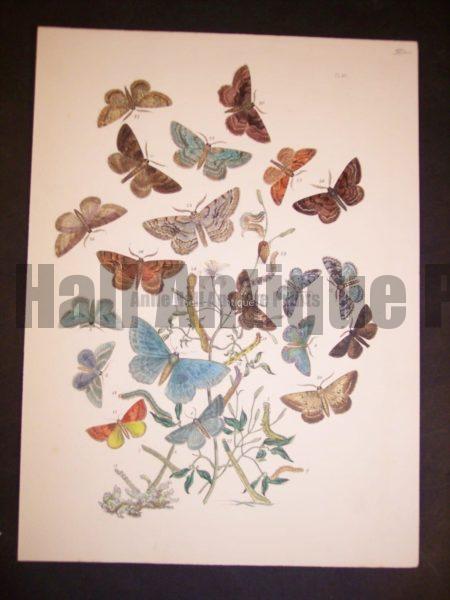
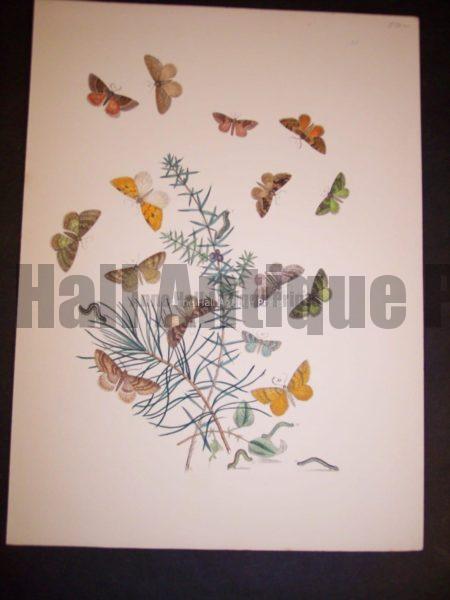
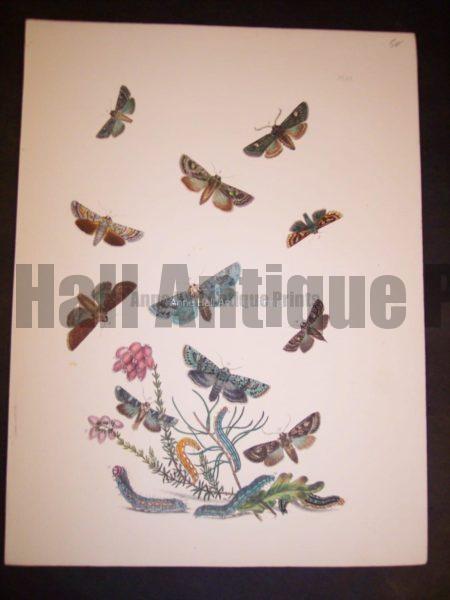
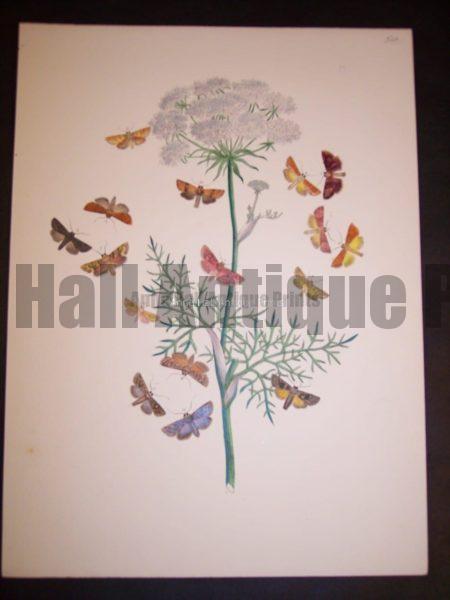
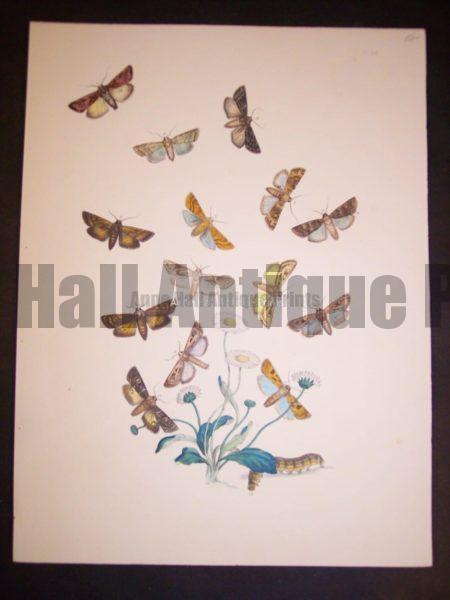

Nodder Butterfly Prints. 18th Century, Antique Engravings of Butterflies.
Nodder Butterfly Engravings. Hand colored 18th Century prints published in England c.1790. Stunning condition and colors. Each print measures about 5×9″ Check back for more. Click here to contact us.
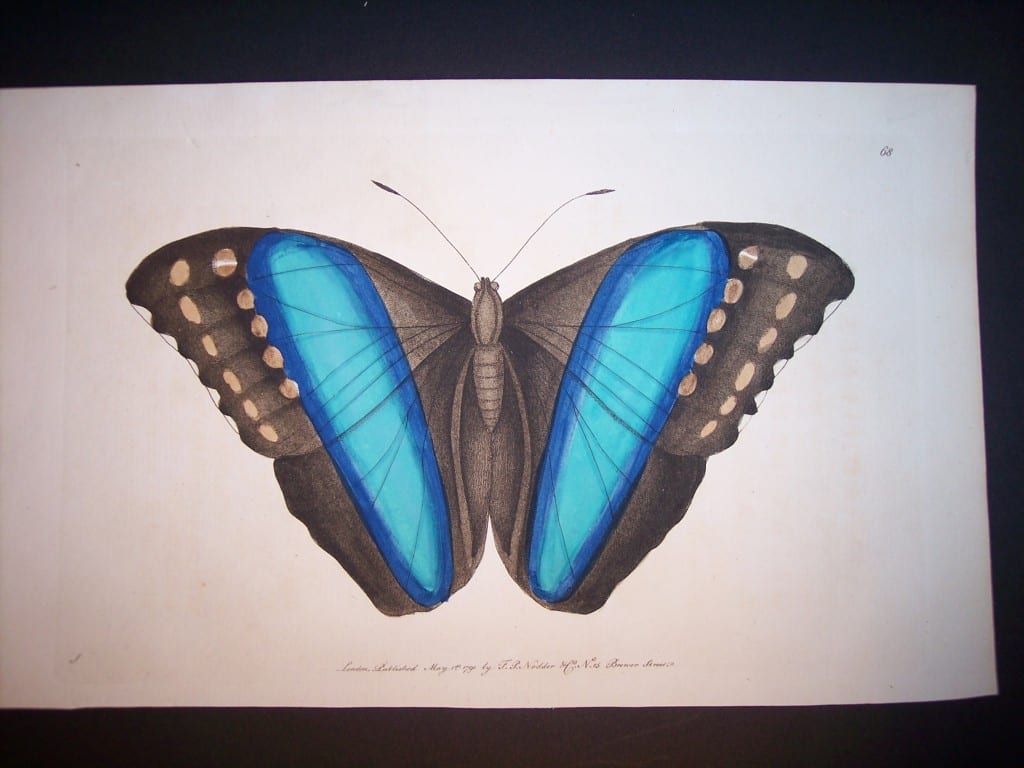
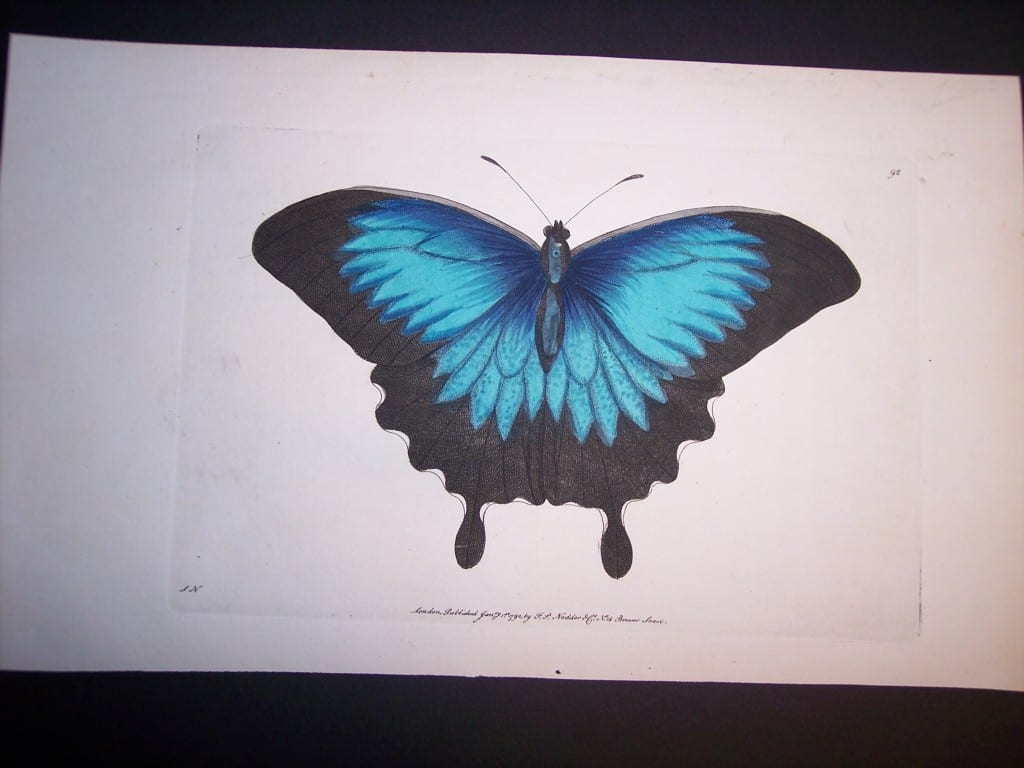
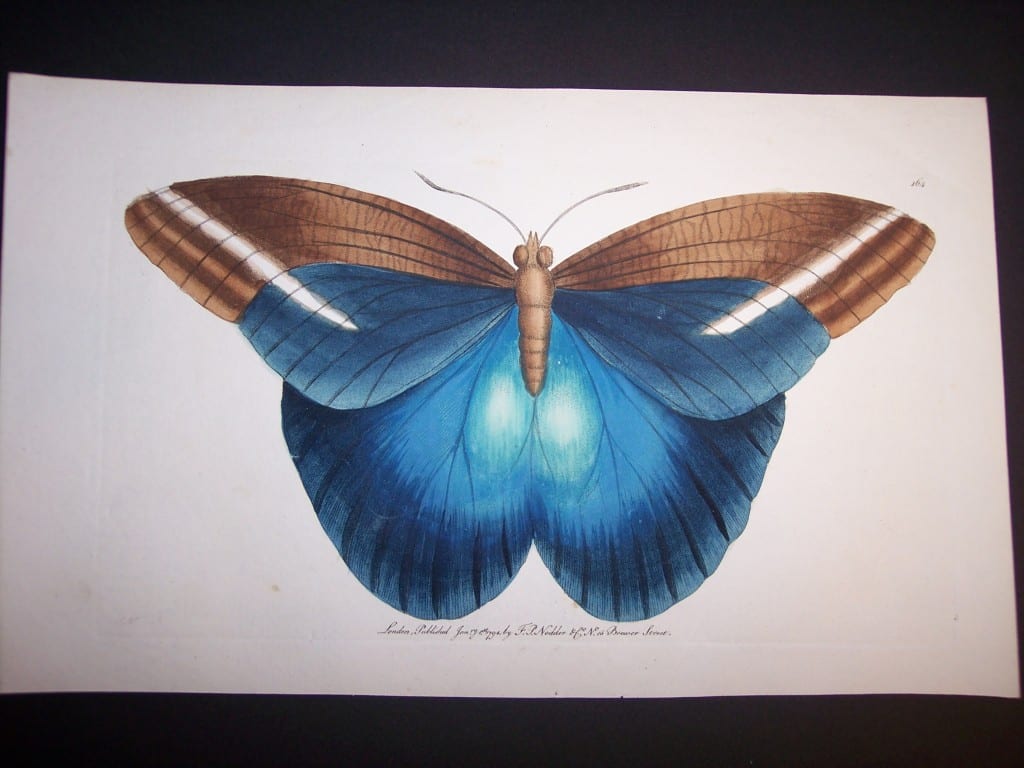
In 1699, at age 52, Merian decided to go to Suriname, where her older daughter, Johanna Helena, the wife of a Dutch merchant, was already living. She sold more than 200 of her paintings to raise money for the trip, and wrote a will before she left. Merian and her younger daughter, Dorothea Maria (age 21), traveled to Suriname and resided as guests of a Labadist plantation. Her observations of the local climate, where she and Dorothea resided during their two-year stay, are expressed in her accounts of Nature: vibrant butterflies, voracious caterpillars and ants, menacing reptiles, exotic fruits and vegetables, and treacherous jungle explorations (Getty Museum, 2008). Her accomplishments included describing the local uses of animals and plants — for some, she gave them their native names (Reitsma, 2008). Though she had hoped to stay in Suriname for five years, Merian developed a tropical fever (malaria?) and had to return home, in 1701, several years earlier than she had anticipated.
Scientific Achievements by Maria Sybilla Merian
Maria Sibylla Merian’s skills in observation and research, and her artistic talents, were a lead into the world of science. She helped to put entomology – the study of insects – onto a more scientific footing. Her publications were in German, or Dutch, rather than Latin, which was the publication language of scientists, at that time. It is of note that, together, her three books generated 19 editions, between 1665-1771. Both of Maria Sibylla’s daughters, Dorothea and Johanna, ensured the circulation of their mother’s scientific artwork.
Upon returning from Suriname, Merian continued to supplement her income by selling insects and other creatures she had preserved. In 1702, the following creatures were listed as “animals in liquid” for sale: 1 crocodile, 2 large snakes, 18 small snakes, 11 iguanas, 1 gecko, and 1 small turtle. This activity continued for another decade. In 1715, Maria Sibylla suffered a stroke and was partially paralyzed. She died in Amsterdam on January 13, 1717. The day of her death a large number of Maria Sibylla Merian’s paintings were sold to an agent of Tsar Peter the Great for his new natural history collection in St. Petersburg, Russia.
References: Bulletin of the Hunt Institute for Botanical Documentation. Vol.22, No. 1, Spring 2010. Pittsburgh, PA: Carnegie Mellon Univ. Jacob-Hanson, Charlotte. August 2000. The Magazine Antiques. New York: Hirschl&Adler Galleries. J. Paul Getty Museum.Getty Center Exhibitions. 2008. Maria Sibylla Merian & Daughters: Women of Art and Science. Reitsma, Ella. 2008. Maria Sibylla Merian & Daughters: Women of Art and Science. Zolle,The Netherlands: Waanders Publishers. Todd, Kim. 2007. Chrysalis: Maria Sibylla Merian and the Secrets of Metamorphosis. Orlando, FL: Harcourt, Inc. Wettengl, Kurt. 1998. Maria Sibylla Merian: Artist and Naturalist. Ostfildern: G. Hatje. Various references were observed to have used different interpretations of : geographic names,, the titles of Merian’s publications, historical information, and the languages used for publications (i.e., Latin, German, Dutch). Christina Clarke February 9, 2015.
Thank you for visiting my website! All of our insect prints are antique lithographs and hand colored engravings and by 18th and 19th Century naturalists & entomologists. Call Anne at 413-245-4197 to discuss your interests.
